Ron Basford, Prime Minister John Turner, Audrey Hepburn & John Bishop
Saturday, March 31, 2007
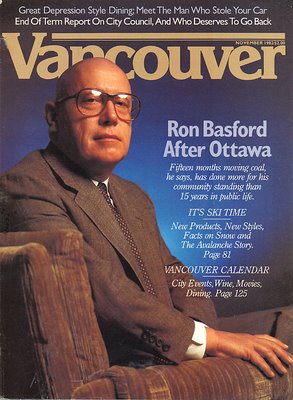
More than perhaps any other date in my life I remember exactly where I was at 1:00 pm on Tuesday September 4, 1984.
This story could be a visual shaggy dog story as I have photographs to illustrate every aspect of it. It began sometime in October 1982 when I was taking photographs of Liberal MP, Ron Basford in his Vancouver office for the November cover of Vancouver Magazine. While attempting to take his portrait our session was interrupted by two phone calls. One was from Prime Minister Pierre Trudeau and the other from Vancouver Mayor Mike Harcourt. To complicate my shoot, Basford had glasses that reflected my lighting umbrella, he had a shiny bald head and no eyelashes or eyebrows. I asked the receptionist if anybody in the office had face powder. Nobody had face powder and my short 30 mintute photo appointment was about to run out. I had an inkling on how to solve the problem. "If you think it will work, use it," Basford told me. The Coffee-Mate worked very well and the shine was off.
John Turner was Prime Minister from June 30, 1984 to September 17, 1984. Elections were to be on September 4, 1984. Vancouver Magazine editor, Mac Parry was planning an issue of Vancouver's top citizens for September. I told Parry that since Turner's riding was in BC he should be one of the citizens and perhaps even on the cover. Parry told me, "Get him for the cover."
The problem was that Turner's campaign manager rudely informed me, "Mr. Turner does not have the time to pose for your city magazine. He is too busy mingling and addressing his constituency." I pointed out that many in Vancouver thought Turner had parachuted into Vancouver and that his face on a Vancouver city magazine that would come out a few days before the federal election would certainly guarantee him a few more votes. My argument went nowhere.
So I called Ron Basford's Ottawa office and asked to speak to him. On the line Basford said, "I hope you have bought genuine face powder by now (I had). What's the problem?" I explained. "Leave it to me, "he said. That evening I received a call from Turner's campaign manager. "Mr. Turner will be waiting for you in his room at the Vancouver Hotel tomorrow morning at 8:15."
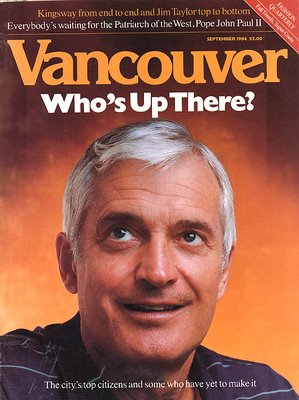
On the morning of the federal election, writer John Lekich and I were at the Four Seasons Hotel. We were there to interview and photograph Audrey Hepburn who was in town as a representative of UNESCO. Lekich warned me, "Don't ask her about any of her former husbands. Movie stars don't like that." Hepburn was wearing a black mock turtle neck top, a black skirt and black flat shoes. She had no jewelry and no makeup. She was only 55 but she looked older. I was shocked to see her alternate between cigarettes and cups of coffee. But she was tall ( I calculate she was 5 ft 10 inches). I asked her if she had ever not appeared with an actor because of her height. "Not true, she asserted, "I made Sabrina with Humphrey Bogart." And then I had to ask her about the famous Bert Stern photograph of her as a bride with her bridegroom Mel Ferrer in a Paris hotel room. She looked at me as if she had had one too many bitter coffees. John had warned me.
To celebrate the occasion I invited Lekich for lunch at John Bishop's Bishop's. I knew that this expensive restaurant wouldn't be so expensive as we would not be able to purchase any liquor. It was federal election day.
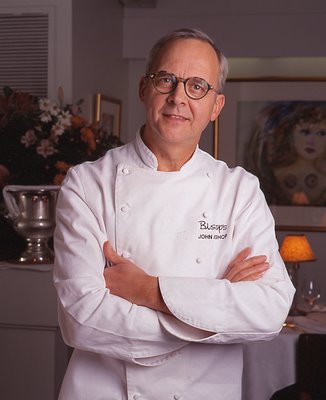
While dining I pointed out to Lekich that there were a couple of men at a table who had wires coming out of their ears. We wondered if they were security guys or spies. We soon found out. From our window seat we saw a large car stop. From it emgerged John Turner. He sat down at a table with some men I could not identify. When he saw me he said, "Hi, Alex." I wished him good luck. But of course on that day he lost.
Lekich and I will never forget that day. I have an extra reason.
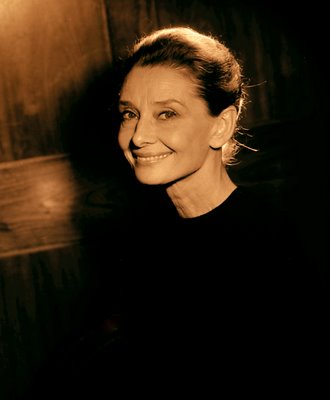
I was so in awe of Hepburn that my photographic instincts were in shambles and I realized that I could not make Hepburn look as she had in Roman Holiday. I could not possibly get close with my mercilessly sharp portrait lens. So I chose to step back and photograph her at a distance. I can assert that my subsequent takes were failures. I should have gotten close, Roman Holiday be damned.
Friday, March 30, 2007
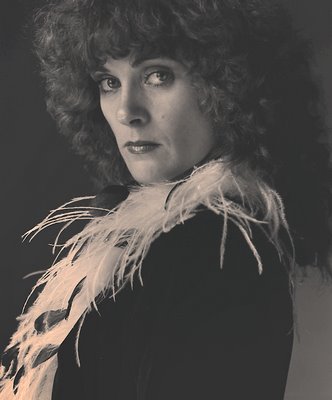
I married Rosemary when both of us were young so I was certainly never a man of the world. Since I had lived most of my life in Latin countries (until we moved to Vancouver 30 years ago) I had lived in sexually repressed Catholic societies. It all changed with a couple of beautiful jazz dancers at the CBC.
My first real break in photography happened around 28 years ago when I was called to shoot stills for the Wolfman Jack Show at the CBC on Hamilton Street. I could not peel my eyes away from the dancers that all CBC variety shows featured. There were a couple that I favoured. I asked cameraman Mike Varga for their names. "They are Jackie Coleman and the one with the legs, that's Viktoria Langton." My mother had a handsome pair of legs as did Rosemary but Langton's were spectacular. During the break the cast and crew went to the CBC cafeteria and I chose to follow the dancers. In spite of being a tad shy I managed to raise enough gumption to sit opposite Coleman and Langton. Both dancers were sweaty and exhausted. Coleman turned to Langton and loudly said, "I want a hamburger and a fuck and in that order." In all my years before and since I have never been so shocked and startled by a woman as I was then.
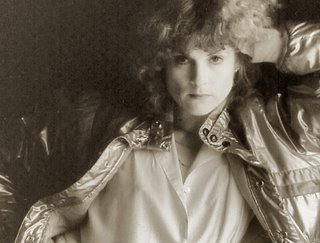
After a few years of working at the CBC doing the variety shows I got to not only know the dancers but I found myself conversing with some of them. My favourite shows were the ones where the dancers were made to wear nylons with seams. Viktoria stood out.
I don't remember the exact circumstances. I don't know if Viktoria asked me or I asked her but the fact is that I photographed her twice.
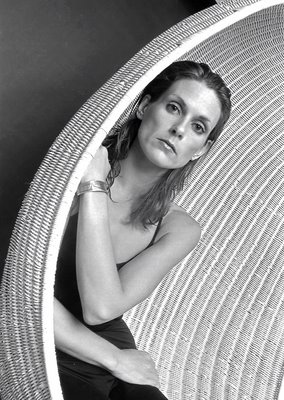
Once in my Burnaby home basement studio (sitting in our Mexican hanging egg chair) and at her home. In both situations my wordly education (nonexistent at the time) was furthered.
Sitting on the egg chair (Viktoria had wet her hair so she looked like she had just stepped out of the shower) she offered, "Do you want me to bare my breasts?" I was too flabergasted by the offer so I muttered a, "It's not necessary." What and idiot I was! Here I had a woman with a face and a pair of cheekbones that Cinemascope was invented for and cold feet were all I could muster.
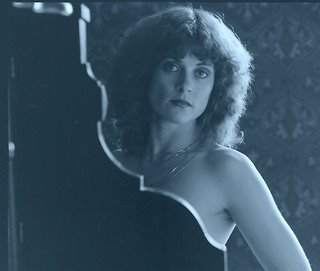
By the time I photographed Viktoria again the offer had more or less closed. While taking her pictures in her bedroom I noticed a device on her bed that suggested that she was quite happy on her own. Perhaps it was only then that I realized that women were as human as I was, even the ones with special legs.
Of those legs I can tell you that I could go into my files and search for pictures of the CBC dancers. Viktoria's legs would stand out. But that will have to wait for another day. Recently Viktoria visited me in my garden and here you can see a couple of excellently turned ankles. You will have to imagine the rest.
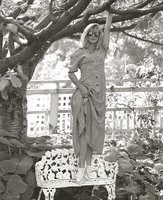
While I am usually polite with most women I have been uncommonly crass in repeatedly asking Miss Langton to undrape for my camera. Her negative replies have been resolute but I have not yet lost all hope.
Adendum
Viktoria Langton has a beautiful smile and a throaty voice with a special South African accent. She was born there.

I married Rosemary when both of us were young so I was certainly never a man of the world. Since I had lived most of my life in Latin countries (until we moved to Vancouver 30 years ago) I had lived in sexually repressed Catholic societies. It all changed with a couple of beautiful jazz dancers at the CBC.
My first real break in photography happened around 28 years ago when I was called to shoot stills for the Wolfman Jack Show at the CBC on Hamilton Street. I could not peel my eyes away from the dancers that all CBC variety shows featured. There were a couple that I favoured. I asked cameraman Mike Varga for their names. "They are Jackie Coleman and the one with the legs, that's Viktoria Langton." My mother had a handsome pair of legs as did Rosemary but Langton's were spectacular. During the break the cast and crew went to the CBC cafeteria and I chose to follow the dancers. In spite of being a tad shy I managed to raise enough gumption to sit opposite Coleman and Langton. Both dancers were sweaty and exhausted. Coleman turned to Langton and loudly said, "I want a hamburger and a fuck and in that order." In all my years before and since I have never been so shocked and startled by a woman as I was then.

After a few years of working at the CBC doing the variety shows I got to not only know the dancers but I found myself conversing with some of them. My favourite shows were the ones where the dancers were made to wear nylons with seams. Viktoria stood out.
I don't remember the exact circumstances. I don't know if Viktoria asked me or I asked her but the fact is that I photographed her twice.

Once in my Burnaby home basement studio (sitting in our Mexican hanging egg chair) and at her home. In both situations my wordly education (nonexistent at the time) was furthered.
Sitting on the egg chair (Viktoria had wet her hair so she looked like she had just stepped out of the shower) she offered, "Do you want me to bare my breasts?" I was too flabergasted by the offer so I muttered a, "It's not necessary." What and idiot I was! Here I had a woman with a face and a pair of cheekbones that Cinemascope was invented for and cold feet were all I could muster.

By the time I photographed Viktoria again the offer had more or less closed. While taking her pictures in her bedroom I noticed a device on her bed that suggested that she was quite happy on her own. Perhaps it was only then that I realized that women were as human as I was, even the ones with special legs.
Of those legs I can tell you that I could go into my files and search for pictures of the CBC dancers. Viktoria's legs would stand out. But that will have to wait for another day. Recently Viktoria visited me in my garden and here you can see a couple of excellently turned ankles. You will have to imagine the rest.

While I am usually polite with most women I have been uncommonly crass in repeatedly asking Miss Langton to undrape for my camera. Her negative replies have been resolute but I have not yet lost all hope.
Adendum
Viktoria Langton has a beautiful smile and a throaty voice with a special South African accent. She was born there.
Thursday, March 29, 2007
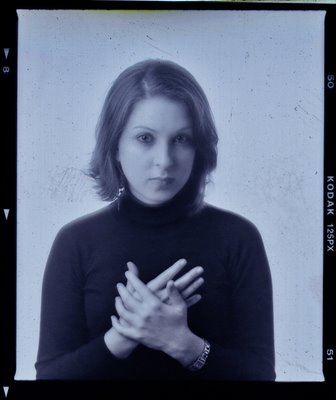
Bob Mercer's takeover as both editor and art director of Vancouver Lifestyles Magazine (until recently a magazine with no visible redeeming qualities) has given me the opportunity to explore areas of photography that I discovered with the introduction of an Epson 1640 SU flatbed scanner into my photographic equation about 4 years ago. The scanner has enabled me to work on what I call a hybrid photographic system. I can merge some of the features of film with computer manipulation. But many of my solutions and discoveries, while they could possibly be executed with an all digital sytem including a digital camera, are due to still thinking of the capabilities of film. With the proliferation of digital cameras and the mentality that all you need is the camera in your hand (no need to connect either by wire or by radio a good lighting system!) to make (capture is the going word) a good image, uniformity is the apparent rule. For me the results all seem to look like most, if not all, the photographs posted on Flickr.
The scanner has made me realize that at age 64 I am shooting what I think are some of my best photographs but also I have the idea that better ones are still to come.
In the lastest issue of VLM I have a photograph of young Vancouver jazz pianist Amanda Tosoff. Last week, on Wednesday at 8, I wanted to listen to her with her trio at her regular gig at the Libra Room on Commercial. I wanted to take my piano student granddaughter, Rebecca who was on spring break. Alas I was too sick to go so we will have to wait for another opportunity. I am particularly intrigued in that she plays some jazz standards by Horace Silver, a jazz pianist that both Rebecca and I like.
I took this photograph with a plain white background and I then scanned the b+w negative as a colour negative. By doing this I am able to tint the result with whatever colour I wish. I then placed the negative on my flatbed scanner. On top of the negative I lay a sheet of white letter paper. I scanned it. The result was a negative that I reversed to make a positive. The positive showed the textures and deffects that the scanner read in the paper.
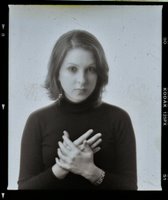
I then chose a suitable colour. The second version seen here is the one Mercer chose to run.
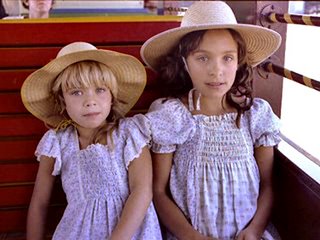
Sometimes I feel justified to use a photograph from a past blog.
I took this picture in 1979 when Hilary (now Hilary Stewart) was 7 and Alexandra (always Ale) was 11. The framed picture hangs on one of our stair walls and I see it every time I go down in the morning or when I visit the kitchen in the evening for a snack.
For me the photo is memorable on many levels. At the time I had given Rosemary a state-of-the-art automatic camera, a Pentax ME. I brought along all my cameras for that 1979 trip on the Royal Hudson but it was with Rosemary's ME and Kodacolor film that I snapped this photograph. It is one, of a very few group of iconic pictures that I ever took of my daughters together.
I was younger and I had no experience in being a father, in knowing what to tell them or how to help educate them. It seemed that both Rosemary and I were doing it on the fly. And we did a lot of driving.
I remember that we would pick up the girls at their French Immersion schools in Coquitlam and then drive them to their ballet and guitar (Ale) classes at the Vancouver School of Music by the Planetarium. We drove them to Burnaby's (we lived there) CG Brown Pool for swimming classes. Finally Rosemary insisted that the girls learn to ice skate and to ski. During many weekends we drove to Mt Seymour or deposited the girls at the Grouse Mountain gondola. Yet their childhood seems one big blur for me. Somehow this picture distills some of the happy moments and also suggests that we may have been on the right track.
I cannot bring those memories back. But I have happily discovered that I can relive them through my grandchildren Rebecca and Lauren. I have more patience, and this time around, I know I will not have the luxury to write here that it all, too, has become a blur in my memory. Somehow that is not only reassuring but also extremely exciting.
 Here they all are although I took this in August 2003.
Here they all are although I took this in August 2003.
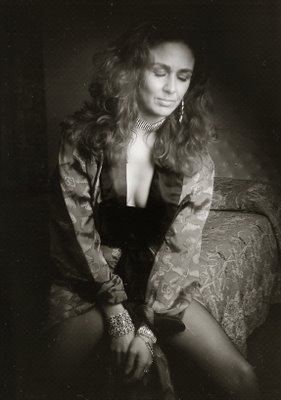
My relationship with the three Milne sisters came about as an addendum to my friendship with fellow photographer Ian McGuffie. I first met Carol Milne when she worked at Lens & Shutter in the early 80s. I remember her as a glamourous woman who had a penchant for wearing magnolias in her hair. In subsequent gatherings with her at the Railway Club she came to the conclusion I was a chauvinist pig and all shields were up. The fact that I indicated I wanted to photograph her lovely cleavage might have been part of the problem. A second sister, whose name I have forgotten, was a bus driver when I first met her. Our conversations were pleasant. The third sister, Anastasia, was much more elusive, glamourous and mysterious. She would appear at parties at Carol's house with a young man she mostly igored. She moved exactly like Audrey Hepburn in Breakfast at Tiffany's.
Sometime in the early 90s Ian suggested we photograph Anastasia together. This was an odd request. I never chose to ask Ian if in his past he had a relationship with either Carol or Anastasia, but there was something there. In the early 90s I was exploring photographic sensuality in my version of Helmut Newton. Since I could not find luxurious Paris hotels for my experiments I made Tony Ricci's Marble Arch my headquarters and in particular one of the better rooms that featured a sitting room, a separate bathroom and an ominous chain lock on the door.
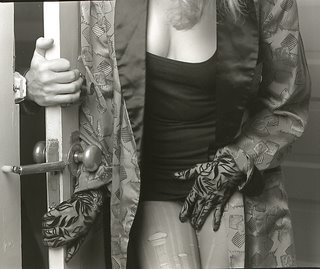
With my shoot with Anastasia I further tried out an extremely sharp film, Technical Pan and I used both my conventional medium format camera and a 6x9 inch German Gevabox. The latter was a fixed focus and most primitive box camera. The first picture, top left, is an example of the Gevabox.
Tony gave me access to two rooms and the procedure was that one of us would wait in one room while the other would take photographs of Anastasia. I never saw Ian's pictures and he indicated that Anastasia hated mine. I quickly buried the negatives in my files. Looking at them now I don't think they are all that bad. I did learn one thing and that was to appreciate torn nylons.
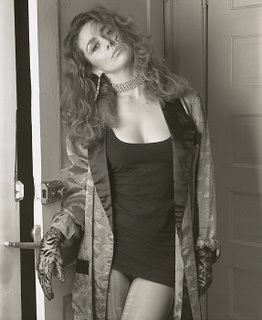
Perhaps I simply never got past a perfunctory knowledge of what the Milne sisters were all about.
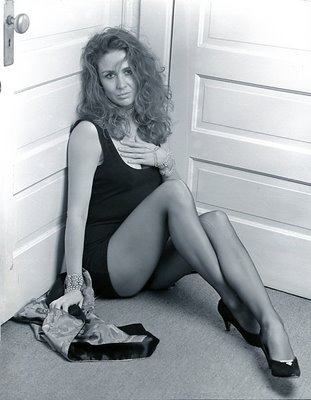
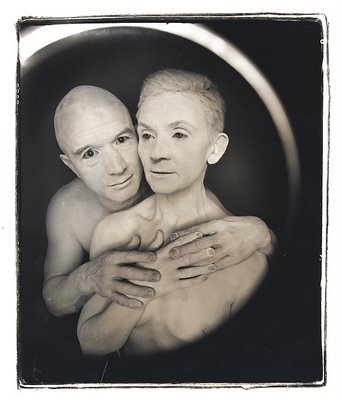
In my CD collection I have some Alban Berg piano sonatas and a 3 CD set called The Glenn Gould Legacy - Scriabin - Schoenberg - Berg - Prokofief - Hindemith - Krenek. After having tried many times I have retired these CDs. I find them unlistenable. Many have said that this kind of music is remote. I would not entirely agree. I have enjoyed Vancouver New Music Recitals without any problem. The difference must lie in seeing the performances.The same can be said about contact improvisational dance and Butoh. They have to be seen.
Rebecca (my 9-year-old granddaughter) and I went to a somewhat difficult program on Saturday. It was particularly hard on me as I had a terrible cough which I controlled with A Shopper's Drug Mart codeine cough syrup and Fishermen's Friends lemon-flavoured drops. The program was two-and-a-half hours long. I am sure that at least 30 minutes could have been cut.
Both Rebecca and I had seen Kokoro's brand of Butoh before. It is a form of modern Japanese dance that emerged after WWII. Depending on how you look at it I got the impression, as did Rebecca, that I was watching a couple of ghouls from The Night of the Living Dead (even if both Jay Hirabayashi and wife Barbara Bourget had their white makeup). Then some of the ungraceful hand positions would shift and their movements became exquisitely graceful, all enhanced by a slowness that looked easy only at first glance. For these Butoh dancers to keep some of the positions, in which their spinal columns are bent for long periods of time, must force a tremendous control and a need for great strength.
I must admit that the more I see Butoh the more it grows on me. In this last performance I was particularly delighted that Bourget did not colour her lovely red hair. And after having seen Hirabayashi a week back in Karen James's Sisyphus I know that this 60-year-old man can "conventionally" out perform just about any other man in town.
All in all I would say that Rebecca must have been very proud of her grandfather. After all, he was able to survive such a "difficult" program without demanding to go home early.
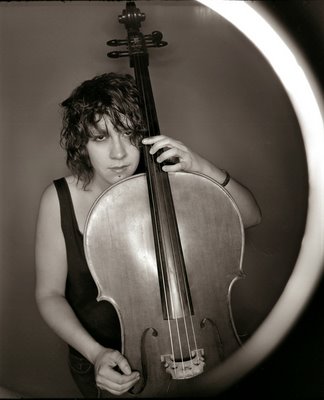
When I first started working at Tilden-Rent-A-Car on Alberni Street some 30 years ago I was told not to rent cars to anybody whose last name was John or George. When I pressed the manager for details he said, "Just don't rent cars to Indians." I could not understand why, so when a large man with long hair, called Moving Rock showed up for a station wagon I gave it to him I gave it to him even though his driver's licence was suspicious. The vehicle appeared in Arizona a couple of months later and I was almost fired. One of my better clients was a black pimp from Seattle called Johnny Stone who never gave me any trouble. The manager told me to stop renting to rocks, boulders and stones.
I am from a generation that remembers the map of Africa being full of countries that had red borders as they were British territories. In that youth of mine maps showed men in conical hats planting rice in China, a Mexican would be sleeping under a cactus and Germans would be wearing short leather pants with a feather in a cap. All was hermetic and logical. Mexicans lived in Mexico and Argentines in Argentina.
After having read so much about "red Indians" I was astounded to see my first "Indians" in Vancouver. I found them odd as they were Mexicans who did not understand my Spanish. My wife Rosemary had never seen an Indian in her native New Dublin, Ontario. Her first sighting of a totem pole had been the one in Chapultepec Park in Mexico City.
After Moving Rock I rarely ever had a contact with an Indian. In the years that I worked as a stills photographer at the local CBC I never spotted an Indian. I asked around and was told, "They are not interested in working here." In fact the only Indian I then saw at the CBC was the one who was a character in the Beachcombers.
It was about 25 years ago when people seemed to give parties and Rosemary and I would drive to them on Saturday nights. More often than not the program on CBC was Our Native Land. This radio program featured native Canadian culture, songs and news. I enjoyed listening to it except Rosemary was not tolerant of anything that sounded like chanting and she would demand I turn the radio off.
Through the years I have had a few situations where I have photographed such people as Chief Dan George and his son Chief Len George. I photographed several members of the Sparrow family but I have never managed to connect past the photograph.
Last week I was fascinated by the Native Canadian influence in Karen Jamieson. Last night Rebecca and I went to an evening at the Vancouver East Cultural Centre that featured assorted groups of which only Kokoro Dance was familiar. Rebecca and I were blown away by half-Cree cellist Cris Derksen and Inuk throat singer Tanya Tagaq.
During my session in my studio with Cris Derksen, Derksen had asserted, "Tanya Tagaq is pure sex." She was right. I was exhausted by Tagaq's performance and Rebecca told me, "My throat hurts from just listening to her."
In the end both Rebecca and I enjoyed Cris Derksen, best. She did a little singing which was a blend of the avant-garde and what sounded like traditional Native Canadian chanting. Dersken started with an amplified version of Bach's Suite No 1 for cello. From there she degenerated beautifully into sounds we had never heard before.
We were both seduced.
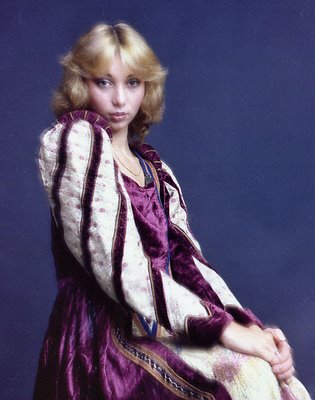
On Christmas Eve 1966 my Argentine Merchant Marine ship the Río Aguapey docked in New Orleans. I decided to visit the city on my own and immediately went to the then notorious Bourbon Street in the French Quarter. I had never ever had a bourbon or seen a burlesque act so I followed some sailors into a club. I asked for my bourbon (it was terribly strong) and sat up front (in later years in Vancouver this was called "gynecology row"). A perfectly bored woman appeared on stage and she proceded to plug in an electrical cord to the wall oulet. This, I immediately found out was her music player. She then danced around looking extremely bored and by the time most of her clothes were off I was out of the joint. I left with the impression that the woman was some sort of robot who plugged herself in and then danced.
It was around 1978 that I finally overcame my curiousity to enter the Drake Hotel Pub Lounge. I had been told that terrible things happened here and that no decent young man (by then I was 34) would ever be caught in there. I sat down and ordered my beer. I felt obliged to order beer even though I have never liked it. On stage I saw a very young (20, at the most) blonde girl with a bob haircut and legs that seemed to go on forever. She danced with skill, energy and with a beautiful smile on her face. I was so enamoured that I returned again and I soon was a Vancouver fan of the ecdysiast art. I became a fan of Cheri (that was her name) and of Tarren Rae (the only girl who could compete with Cheri in having long and shapely legs).
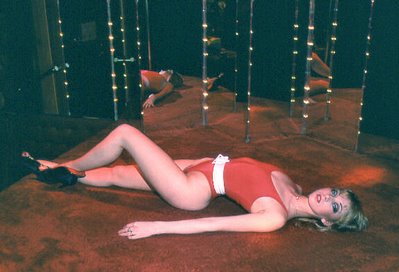
Cheri (on the Drake stage, right) had been known to kick so high that she once managed to break her nose with one of her legs.
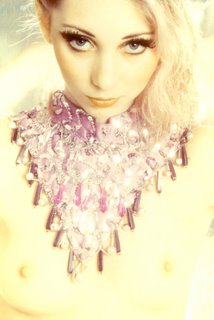
It didn't take me long to insinuate myself into the presence of these dance queens so that I could try out my new flash equipment and learn to make beautiful women more beautiful and prove Mac Parry, the editor of Vancouver Magazine, wrong as he had asserted that I made beautiful women ugly and ugly women uglier.

While working at Tilden Rent-A-Car some 30 years ago I decided to learn to swim with style so I took a stroke improvement class at the YMCA. A French-Canadian fellow swimmer found out I was a photographer and she asked me to take her portrait. I did not know that she worked at the gift department of Holt Renfrew nor did I know that she slipped my colour 8x10 prints into many of the frames of her deparment. Then one day Marlene Cohen (of Army & Navy fame) entered the gift department and I ended up taking portraits of the whole Vancouver Cohen family. It was Mrs Joe Cohen who told me to look up Gabriel Levy who was the fashion writer for Vancouver Magazine. Levy looked at my portraits and said (to my chagrin), "You are a good portrait photographer but you will never shoot fashion." He then gave me his card to take to Rick Staehling who was the art director at Vancouver Magazine. Shortly after I quit my job at Tilden and became a freelancer.
Except for once (a spread in Vancouver Magazine) I never shot fashion and I was jealous of all those photographers like Howard Fry who photographed beautiful women and were paid to do it. For some years in the late 80s to early 90s I shared a huge studio in Yaletown with Denis Montalbetti who did a lot of fashion. In particular I was jealous of his shooting the Vancouver super model Karen Campbell. One night in particular Karen Campbell was posing for him while in a corner I was taking portraits of Gavin Walker with his sax and Kool cigarettes. As much as I like and liked Gavin Walker I felt shortchanged.
In May 1989 John Lekich and I decided to correct the situation by offering the Georgia Straight an article on a beautiful blonde ( who happened to be Karen Campbell). The Intro article saw the light of day. In those days it was enough to be beautiful and blonde. Or at least it was enough for editor Charles Campbell (no relation!).
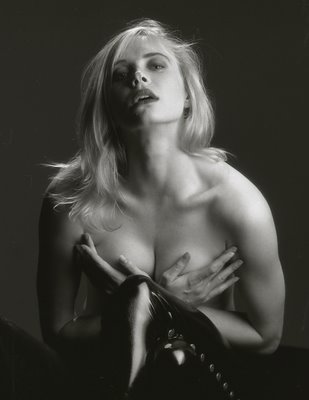
Shortly before Levy died of AIDS in the early 90s he summoned me for a favour. He wanted me to shoot a couple of nude men for a calendar contest for a gay club called Neighbour's. The winner of the contest (one of the nude men)was going to have an expenses paid trip to Hawaii. During the shoot Levy confessed to me, "I was wrong about you. You are an excellent fashion photographer." Without him knowing his correction came too late to ruin my photographic career. In Vancouver, with the loss of Woodward's, Eaton's and Bay catalogues, had I been a fashion photographer I would not be in business now.
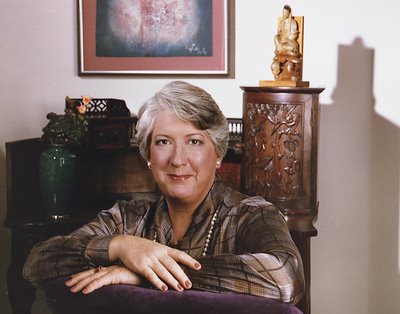
In the mid 80s Vancouver Magazine editor Mac Parry summoned freelance writer Mark Budgen. Mac wanted Budgen to write a profile on the influential Progressive Conservative MP, Pat Carney. It seems that Budgen (he does not deny this but does not remember his exact words) turned Mac down telling him that Carney's political position (right) did not fit with his own (left).
I have known Budgen for close to 30 years and we have traveled to Perú, Uruguay and Argentina on magazine assignments. In Buenos Aires godmother/first cousin Inesita O'Reilly Kuker was charmed my him but still gave him the nickname of Marx because of his left-wing views.

A perhaps only a little less ethical Robert (Bob) Hunter accepted the Carney assignment and I was dispatched to take her picture in her Point Grey home. As soon as I found out that Carney had been born in Shanghai I had an idea. I showed up with make-up artist extraordinaire Inga Vollmer. Vollmer made her up and as soon as we were ready to shoot I asked Vollmer to give her some final touch ups. This was my signal for Vollmer to apply what in her consideration was "Chinese Dragon Lady" makeup. I do believe that Carney never looked any better.
Some years later I told writer Ben Metcalfe of my experience with Pat Carney. We were having after dinner cigars and coffee at his Shawnigan Lake cabin. My daughter Ale was there as she had been my assistant in a shoot at Shawnigan Lake School for a fund raising brochure. Ben told me, "When I was working at the Province this short and chubby girl would come to my desk for my copy. I could barely see the top of her head behind my typewriter. It was Pat Carney."
All these years Budgen and I have been friends and I particularly like dining (usually lunch) at his Strathcona Heritage house. Budgen is most frugal, but does not think twice about splurging on good cooking ingredients. He is an excellent cook. One day he had a little shallow porcelain container with little mysterious looking flakes. He passed me a bowl of hard-boiled eggs and told me to try them with the Maldon Salt. He mentioned how so many years ago the Danes had defeated the Saxons in a great battle on the Maldon Sea. "The sea salt that is evaporated from the Maldon Sea waters," budgen said, "has traces of the blood of those English."
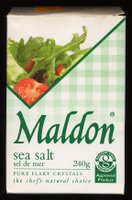
I must add here that I am not the only one addicted to the delights of Maldon Salt. Rebecca, too, demands I serve it and when I am not looking she serves herself an extra pinch.
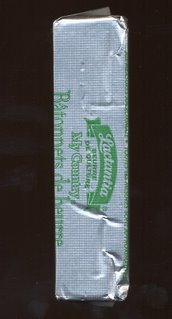
A combination of circumstances have made me think of butter. It is spring and I remember that when we were living in Mexico there was a heavily advertised margarine called Margarina Primavera. or Spring Margarine. There was no way I would have ever tried it as butter has always been the choice in our family. I cannot think of ever using margarine when I went to Aunt Iris's for tea in Buenos Aires. Aunt Iris Hayward made the best deviled ham in the world and to combine it with margarine on her home-made toast would have been a sacrilege.
Because I have a terrible cold I cannot taste anything so it seems that it is up to my imagination to satisfy my tastes. Just a few weeks ago Rebecca reminisced about medias lunas de grasa. These are Argentine croissonts made from lard and lard in Argentina is grasa. These croissonts are chewy and the extra brown ones dunked into café con leche at the Café Richmond on Florida Street is close to being in heaven. Even Jorge Luis Borges knew that as he frequented the café, too.
On the other hand factura (pastry) de manteca (Argentine for butter) is about as light as pastry can ever be. The idea of slathering dulce de leche on a media luna de manteca (a butter croissont) previously buttered with the usual unsalted Argentine spread makes me almost feel like taking the first plane to BA with Rosemary and Rebecca.
In Mexico butter is not manteca but mantequilla as in Spain. Grasa or lard in Argentina is manteca in Mexico.
I can never forget my grandmaother having breakfast or merienda (a Filipino/Spanish version of teatime). Abuelita would butter her bolillos (Mexican French bread buns) with butter (she would have rejected margarine of any kind) then she would put tons of strawberry jam (Mexican strawberry jam has no equal) and then peanut butter. She would dunk it all into her extra sweet café con leche with a smile on her face like a kid about to eat chocolate cake.
Rosemary puts margarine on her toast (health reasons?) but she would never stop buying my Lactancia cultured and unsalted butter. I use it for everything including for all my cooking.
I think that anybody who has ever dunked buttered toast in strong tea must know that the butter that melts into the tea enhances the taste of the tea. Every once in a while when I don't want to make toast with my tea I will slip in a little chunk of butter into my steeping tea.
Rosemary and I do share a little quirky pleasure that would not work with margarine. Every once in a while she will buy a bag of pretzels and both us will scrape a butter stick with pleasure that must be as close to the one of my grandmother dunking her buttered bread into her coffee.
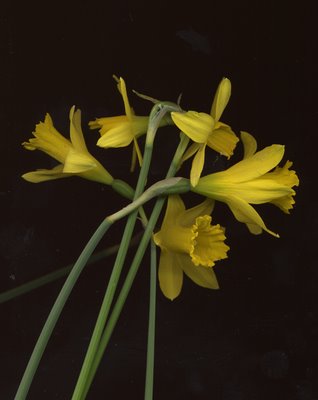
Thinking about spring this morning it ocurred to me that most of my views about it are the same as those about patriotism, planting trees, saving money and the Argentine flag. These iconic concepts came to me early in school and I received them from influential teachers whom I either adored or feared. Some of these concepts such as patriotism and ahorro, (saving money) were to be found in my textbooks that were put together by PR firms that answered to Juan and Evita Perón. Saving money came hand in hand with the Plan Quinquenal (or 5-year plans) in which the Argentine government (Perón) was going to exceed all levels in five years to make our nation a worthy one. We were also told (and all city parks had the sign) that "En La Argentina los únicos privilegiados son los niños," or in Argentina only the children are the privileged ones.
Between the second grade and the third grade we had segundo superior which was an in-between grade that was much tougher than second grade. Some of us who were deemed to possess higher IQs were plunked into it. I have long forgotten the name of my segundo superior teacher. She was strict but I was not afraid of her.
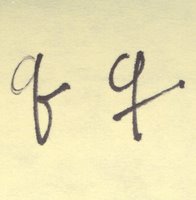
She taught us a different method (simpler she said) of writing the letter "q" in which you just crossed the vertical line instead of making the more difficult squiggle as seen here. I also remember the teacher and this class because a photographer took a classroom picture in which he used magnesium flash powder. I have never forgotten that flash and the poof.
When I gave spring some thought this morning I realized that only now, after all these years, have I stopped looking at the seasons, one at a time, as perfect entities. If you look closely at the daffodils that I scanned today, there is some slug damage. Spring isn't perfect and it already brings with it the decay of fall. I see seasons as brief stopovers into the next ones. The brand new shoe already has that first scuff on it. Accepting the seasons in this less than ideal way, as well as understanding the concepts of patriotism and saving money (in more realistic terms) would suggest that the innocence of youth is finally behind me!
Even the colours of spring have been fixed in my youth. Jacaranda mimosifolia is a tree of my Argentina and my past. In spring, and then for at least two months they bloom bright blue. I cannot thing of a fresher colour than blue to bring in the idea of new things to come. I have never seen yellow or even pink as the colours of spring and Easter.
Jacaranda is a beautiful word from the beautiful language Guaraní which is spoken in northern Argentina, southern Brazil and is one of the two official (with Spanish) languages of Paraguay. This most melodic language stipulates that jacarandá should be pronounced as hacarandá. Properly said (you have to open your mouth for this and put special emphasis on that last syllable as if it were the poof of magnesium powder) jacarandá, the word, is as beautiful as the tree which has always coloured my springs blue. And I still cross my Qs.

"St Helena, the place on earth farthest from any other place." The Monsters of St Helena
Brooks Hansen
I have been reading a delightful novel about Napoleon's days in St Helena and it has coincided with the emergence in my garden of Helleborus argutifolius sometimes called the Corsican Rose since it can be found in Corsica and the Balearic islands. I like the plant because it is all apple green. We seem to ignore flowers that don't have lots of colour. The Corsican hellebore brings me the promise of the greenness of spring.
The novel is The Monsters of St Helena by Brooks Hansen and it is full of detailed information on how Boney spent his last days in exile. True or not he befriends a teenage girl, Betsy Balcombe (the only one on the island who is not afraid of the "monster") and they indulge in pleasant conversation which transforms Napoleon into a delightful old man (true or not). In one of my favourite discourses:
His hair is so fine, she thinks, and silky. Like an infant's. "We had a tutor, Jane and I, but she left."
"This is not good. You will be ignorant." He sits up straight.
"What is the capital of France?"
"Paris."
"And Italy?"
"Rome?"
He thinks. "And what is the capital of Russia?"
"Petersburg now. Moscow formerly."
"Very good." He pauses, slyly. "But do you know who set it on fire?" He leans towards her and his eyes glower. "Qui lá brûlé?"
She sits back. I do not know, sir."
Then they soften just as quickly. He smiles. "Yes, you do. You know very well that it was I who set Moscow on fire." He puffs his chest out like such a silly bird she cannot help herself.
"Oh, no, now I remember. It wasn't you. It was the Russians who burned it, to be rid of the French."
She is correct, and so he sits back with half a smile, conceding defeat. For now.
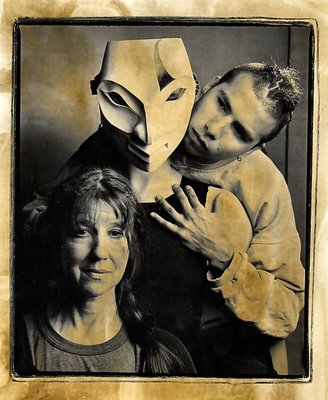
My daughter Ale and I attended an all Karen Jamieson ( left, with Alosun Payne behind mask and Gregory Dominic Odjig) dance evening at the Roundhouse last night. We left completely exhausted, but not as exhausted as Caroline Farquar who carried Brian Solomon on her shoulders for most of the performance in Man Within. After seeing so many women carry men (in Sisyphus) I wondered how Jamieson finds dancers to dance in her grueling works.
Much was written in the previews that Jamieson's Sisyphus was declared to be one of ten choreographic masterworks of the twentieth century by Danse Magazine in 1983. Only one original peformer from the 1980 premiere returned. 60-year-old but very fit, Jay Hirabayashi, made the experience all that more satisfying and believable as a Sisyphus that has to dance for eternity without respite. While I never saw the original work this one seemed fresh, as if it had been choreographed weeks before. Hirabayashi's exhaustion was true.
But it was Jamieson's work that is based on Native Canadian ritual and dance that most appealed to me. Her Crow was like watching the crows that congregate in my garden in the summer and her replication of a dying crow was as real as the ones that have died in my garden from some mysterious virus. In Elmer and Coyote Jamieson paired off with the strikingly handsome and elegant Byron Chief-Moon. He looked like an elder from the past wearing a modern suit.
Some years ago I heard noted luteninsts Stephen Stubbs and Paul O'Dette explain that they had traveled to Paraguay to study how natives there played the mandolin. It seems that the methods for playing a baroque mandolin and guitar had been forgotten in time but those very methods were still in effect in modern Paraguay.
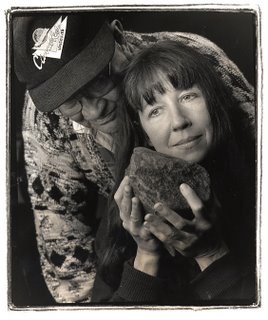
I often wonder why so few (I could be writing here in complete ignorance) native communities have ever adapted their dance and song to modern specifications. My impression is that Jamieson (right, with an elder from Stone Soup) almost works in complete isolation. Her results are wondrous and I will never quite look at a crow in the same way.
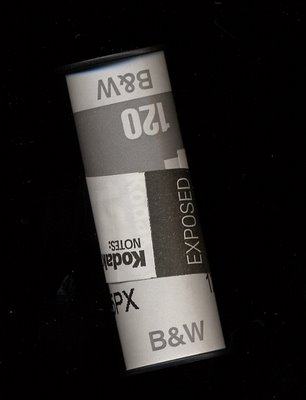
One of Arthur C Clarke's "laws" of prediction states:
Any sufficiently advanced technology is indistinguishable from magic.
Much has been written of intrepid explorers venturing into dark corners of the Amazon jungle and "conquering" hitherto fierce natives by handing them a Polaroid. For me photography has always been magic. The gradual emergence of an image on photographic paper that has been immersed in developer is a rabbit out of a top hat every time. The choice of word, develop, is interesting. At one time photographic plates or rolls of film were not developed but "images were developed out".
At left you see a roll of exposed Kodak Plus X 120 film with which I took 10 exposures of half-Cree cellist Cris Derksen yesterday at 3pm. She told me:
I like your pics... but i also like pics a bit edgy, not so lovely, ya know?
cris derksen
So we took 10 pictures that were a bit edgy but lovely (I think) nonetheless.
I will never be able to resolve (not that I would want to) my sense of wonder at the fact that the above roll has ten latent images of Cris. Somehow the exciting, lovely, intelligent, warm young girl who came into my studio and left a sort of "latent" image of herself in my mind's memory is also captured in that roll of film. I will have to go into my darkroom over the weekend and "develop her out".
Latent is from the Latin latens which means 'hidden' or as applied to photogaphy, the state where something exists but where it is not (not yet) visible. It is the potential aspect of latency that brings in that extra measure of excitement and uncertainty. In my past people would ask me, "Did the pictures come out?"
The more I think of it, that a human being can be parsed into zeros and ones in a digital camera is as much magic as the latent image of film.
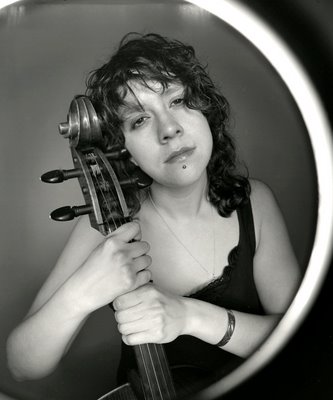
Since I have been assigned by the Georgia Straight to photograph Cris Derksen I cannot show you her developed out picture until next Thursday. The blank (or is that latent?) space you see at right will be filled by the image come Thursday.
And since it is now Thursday here it is.
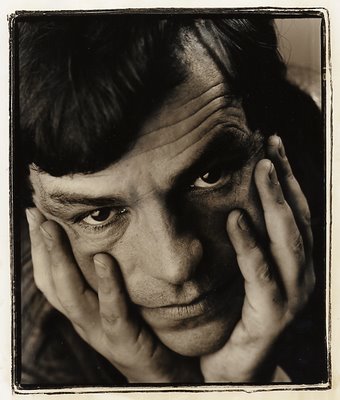
Globalization is homogenizing just about everything. But there are some people who manage to live in isolation and they appear upon us as a complete surprise. I felt this when I listened to my first recording of Cuban pianist Gonzalo Rubalcaba. His brand of jazz was, as Americans are fond to say, "out in left field". I believe that Irish director Neil Jordan's early films had this same flavour. In particular I would cite his adult fairy story In the Company of Wolves, 1984. I was able to photograph him in 1989 at the Meridien Hotel in Vancouver and I forgot to ask him if he played the guitar as his fingernails were cut long. He was interviewed for the Georgia Straight by John Armstrong who was also "out there..."!
I haven't heard much of Jordan of late and that made me think of movie actors who seem to disappear without a trace such as Joseph Cotten who died in 1994 but had faded many years before. I sometimes think that my mother took up smoking so she could do it in the effortless style of Cotten. It was my mother who first took me to see The Third Man and I too fell for the charms of this actor. Many years later I lined up with Les Wiseman outside the Bottom Line in New York City (waiting to get in to see Lou Reed), I remember smoking (the idea was to keep warm as it was a very cold Manhattan winter evening) those awful Mexican Delicados (oval-shaped) and trying to close my eyes just enough to look like Joseph Cotten.
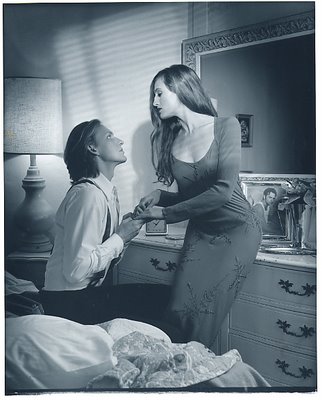
Of late I have been thinking a lot about male ballet dancers and of male contemporary dancers. Besides modern dance there seems to be another category called modern ballet and even sometimes that is modified to contemporary dance. In short, dance that is, strictly speaking, not of the 19th century traditional ballet where the man lifted the woman while she showed off her skills. It is strange that there really is no English counterpart for the female ballerina. One has to say male ballet dancer. In Spanish this difference is not so pronounced. You have bailarina de ballet, bailarina de flamenco and the male equivalent bailarín can be bailarín de ballet o bailarín de flamenco. But as in English the term bailarín for male dancer includes a trumped up idea that the man in question is lacking in manliness.
What is strange is that classical ballet as we know it had its origins in France with Louis XIV and Jean-Baptiste Lully. In the 1650s and 1660s Lully composed ballets for which both he and the king danced. Across the border in Spain there was already a tradition of la lidia or bullfighting. It is this latter English translation that includes the word fight that has made so many who do not understand the bullfight, think it is some sort of sport. These taurophobes will then complain that the bull has no chance.
But if you look at a bullfight as dance, in which a man has to be graceful at all times in the presence of some danger from an animal who is not always predictable, then you must see it with a different perspective.
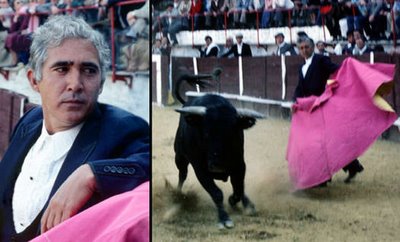
The movements of very good bullfighters are very stylized and graceful, almost feminine. My favourite was Paco Camino, right, photo by D'Lynn Waldron, who dominated bullfighting in Mexico in 1964. I never liked the crassly brave Cordobés who was much too brave but not graceful enough for my concept of the classic matador. I can think of nobody, of whatever sex, who can be more graceful than Camino, Manolete or a Dominguín. Yet both Tyrone Power ( he played a bullfighter in Blood and Sand, 1941) or Ernest Hemingway in Death in the Afternoon, would assure us that bullfighting was and is a most manly endeavour which will guarantee a legion of female admirers.
I made this connection not too long ago and I have really, of late come to appreciate the talents of the male dancer in both ballet and modern dance. I have many favourites in Vancouver, such as Peter Bingham of Edam and Ballet BC's Edmond Kilpatrick. I am particularly thrilled that the latter teaches Rebecca jazz dance at Arts Umbrella.
But my all-time favourite was (he now dances in Europe) Mirososlav Zydowicz seen here in the best room of the Marble Arch Hotel with Andrea Hodge (behind them in the frame is my photograph of that most manly poet, Michael Turner taken in the same room). To watch these two dance was pure electricity. Miroslav conveyed an extreme passion (that I have yet to see again in Vancouver) while Andrea with her classic profile and classic ballet style managed to make my blood both freeze and boil when I watched them dance together.
Emily Molnar once explained to me how a dancer moves through space and cuts invisible swaths of space-time that remain long after the dancer has moved to a different part of a stage. I would like to further stretch Molnar's idea in that I can still see in my mind's eye those wonderful collaborations of Miroslav Zydowicz and Andrea Hodge as ghosts when I watch Ballet BC perform.
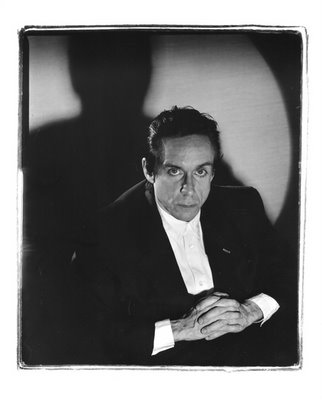
In 1989 I had the good fortune to photograph a drug free and sober Iggy Pop at the Fours Seasons Hotel. I decided to use a dramatice spotlight low on him for my picture and when I looked at him through my viewfinder I recalled a photograph taken by Alfred Eisenstaedt in 1939 in Geneva when he was covering the League of Nations Assembly. His subject was Joseph Goebbels, Hitler's propaganda minister. In retrospect that photograph of the man with an annoyed and malign expression proved all too prophetic of horrors to come.
I mentioned this to Iggy (it sounds odd to write Mr. Pop or even Pop) who immediately became very excited and told me he had been to the very house in Geneva.
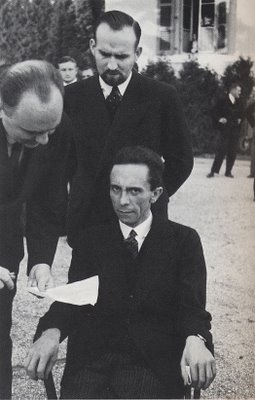
He then posed for me and gave me the closest malign expression he could muster. For a gentleman like Iggy Pop this was hard to do but I appreciated his gesture.
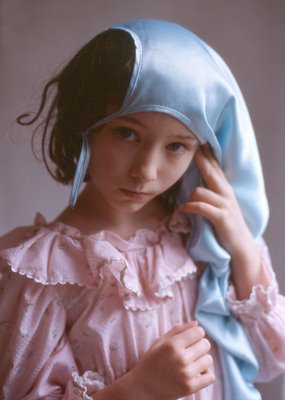
Every time Rebecca and Lauren come to stay with us on Saturdays with the usual sleep over, I am ostracized to what used to be Hilary's (Rebecca and Lauren's mother) room for the night. It is a sacrifice that has its rewards. It is during the day that the two girls make a mess of our bedroom when they raid Rosemary's closet. They take out her shoe boxes and within minutes there are shoes everywhere. Rebecca, in particular, looks to see what she can find hanging in Rosemary's racks. One of her favourite items is an aqua coloured satin nightie I bought Rosemary at Eaton's some 28 years ago. Rosemary unromantically pointed out to Rebecca that it was 100% polyester.
This time Rebecca combined clothing in the same time era as she also found a dress our Mexican housekeeper, Clemen, had made for Hilary an equal amount of years ago. Saturday was a dreary day so I marched Rebecca to our entrance for some photographs. She protested that it was too cold. Every time a car passed by she would run into the house. She did not want to be seen. I managed a few glum photos that I still happen to like.
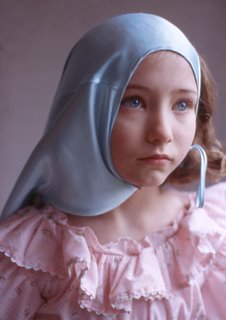
That evening I watched The Saboteur, Code Name Marituri (1965) with Yul Brynner and Marlon Brando speaking a German accent as unconvincing as his bleach-blonde SS officer role in The Young Lions (1958). It was around 10:30 when Rebecca came down to watch the movie with me and by then it had been going on for almost an hour. It was difficult to explain to her who were the good Germans and the bad Germans. But she persisted a stayed until the end.
I think that the time for watching Beau Geste is coming up on us.

Bob Mercer's takeover as both editor and art director of Vancouver Lifestyles Magazine (until recently a magazine with no visible redeeming qualities) has given me the opportunity to explore areas of photography that I discovered with the introduction of an Epson 1640 SU flatbed scanner into my photographic equation about 4 years ago. The scanner has enabled me to work on what I call a hybrid photographic system. I can merge some of the features of film with computer manipulation. But many of my solutions and discoveries, while they could possibly be executed with an all digital sytem including a digital camera, are due to still thinking of the capabilities of film. With the proliferation of digital cameras and the mentality that all you need is the camera in your hand (no need to connect either by wire or by radio a good lighting system!) to make (capture is the going word) a good image, uniformity is the apparent rule. For me the results all seem to look like most, if not all, the photographs posted on Flickr.
The scanner has made me realize that at age 64 I am shooting what I think are some of my best photographs but also I have the idea that better ones are still to come.
In the lastest issue of VLM I have a photograph of young Vancouver jazz pianist Amanda Tosoff. Last week, on Wednesday at 8, I wanted to listen to her with her trio at her regular gig at the Libra Room on Commercial. I wanted to take my piano student granddaughter, Rebecca who was on spring break. Alas I was too sick to go so we will have to wait for another opportunity. I am particularly intrigued in that she plays some jazz standards by Horace Silver, a jazz pianist that both Rebecca and I like.
I took this photograph with a plain white background and I then scanned the b+w negative as a colour negative. By doing this I am able to tint the result with whatever colour I wish. I then placed the negative on my flatbed scanner. On top of the negative I lay a sheet of white letter paper. I scanned it. The result was a negative that I reversed to make a positive. The positive showed the textures and deffects that the scanner read in the paper.

I then chose a suitable colour. The second version seen here is the one Mercer chose to run.
A Photograph Revisited
Wednesday, March 28, 2007

Sometimes I feel justified to use a photograph from a past blog.
I took this picture in 1979 when Hilary (now Hilary Stewart) was 7 and Alexandra (always Ale) was 11. The framed picture hangs on one of our stair walls and I see it every time I go down in the morning or when I visit the kitchen in the evening for a snack.
For me the photo is memorable on many levels. At the time I had given Rosemary a state-of-the-art automatic camera, a Pentax ME. I brought along all my cameras for that 1979 trip on the Royal Hudson but it was with Rosemary's ME and Kodacolor film that I snapped this photograph. It is one, of a very few group of iconic pictures that I ever took of my daughters together.
I was younger and I had no experience in being a father, in knowing what to tell them or how to help educate them. It seemed that both Rosemary and I were doing it on the fly. And we did a lot of driving.
I remember that we would pick up the girls at their French Immersion schools in Coquitlam and then drive them to their ballet and guitar (Ale) classes at the Vancouver School of Music by the Planetarium. We drove them to Burnaby's (we lived there) CG Brown Pool for swimming classes. Finally Rosemary insisted that the girls learn to ice skate and to ski. During many weekends we drove to Mt Seymour or deposited the girls at the Grouse Mountain gondola. Yet their childhood seems one big blur for me. Somehow this picture distills some of the happy moments and also suggests that we may have been on the right track.
I cannot bring those memories back. But I have happily discovered that I can relive them through my grandchildren Rebecca and Lauren. I have more patience, and this time around, I know I will not have the luxury to write here that it all, too, has become a blur in my memory. Somehow that is not only reassuring but also extremely exciting.
 Here they all are although I took this in August 2003.
Here they all are although I took this in August 2003.
Anastasia Of The Three Milnes
Tuesday, March 27, 2007

My relationship with the three Milne sisters came about as an addendum to my friendship with fellow photographer Ian McGuffie. I first met Carol Milne when she worked at Lens & Shutter in the early 80s. I remember her as a glamourous woman who had a penchant for wearing magnolias in her hair. In subsequent gatherings with her at the Railway Club she came to the conclusion I was a chauvinist pig and all shields were up. The fact that I indicated I wanted to photograph her lovely cleavage might have been part of the problem. A second sister, whose name I have forgotten, was a bus driver when I first met her. Our conversations were pleasant. The third sister, Anastasia, was much more elusive, glamourous and mysterious. She would appear at parties at Carol's house with a young man she mostly igored. She moved exactly like Audrey Hepburn in Breakfast at Tiffany's.
Sometime in the early 90s Ian suggested we photograph Anastasia together. This was an odd request. I never chose to ask Ian if in his past he had a relationship with either Carol or Anastasia, but there was something there. In the early 90s I was exploring photographic sensuality in my version of Helmut Newton. Since I could not find luxurious Paris hotels for my experiments I made Tony Ricci's Marble Arch my headquarters and in particular one of the better rooms that featured a sitting room, a separate bathroom and an ominous chain lock on the door.

With my shoot with Anastasia I further tried out an extremely sharp film, Technical Pan and I used both my conventional medium format camera and a 6x9 inch German Gevabox. The latter was a fixed focus and most primitive box camera. The first picture, top left, is an example of the Gevabox.
Tony gave me access to two rooms and the procedure was that one of us would wait in one room while the other would take photographs of Anastasia. I never saw Ian's pictures and he indicated that Anastasia hated mine. I quickly buried the negatives in my files. Looking at them now I don't think they are all that bad. I did learn one thing and that was to appreciate torn nylons.

Perhaps I simply never got past a perfunctory knowledge of what the Milne sisters were all about.
One More For John

Kokoro Dance
Monday, March 26, 2007

In my CD collection I have some Alban Berg piano sonatas and a 3 CD set called The Glenn Gould Legacy - Scriabin - Schoenberg - Berg - Prokofief - Hindemith - Krenek. After having tried many times I have retired these CDs. I find them unlistenable. Many have said that this kind of music is remote. I would not entirely agree. I have enjoyed Vancouver New Music Recitals without any problem. The difference must lie in seeing the performances.The same can be said about contact improvisational dance and Butoh. They have to be seen.
Rebecca (my 9-year-old granddaughter) and I went to a somewhat difficult program on Saturday. It was particularly hard on me as I had a terrible cough which I controlled with A Shopper's Drug Mart codeine cough syrup and Fishermen's Friends lemon-flavoured drops. The program was two-and-a-half hours long. I am sure that at least 30 minutes could have been cut.
Both Rebecca and I had seen Kokoro's brand of Butoh before. It is a form of modern Japanese dance that emerged after WWII. Depending on how you look at it I got the impression, as did Rebecca, that I was watching a couple of ghouls from The Night of the Living Dead (even if both Jay Hirabayashi and wife Barbara Bourget had their white makeup). Then some of the ungraceful hand positions would shift and their movements became exquisitely graceful, all enhanced by a slowness that looked easy only at first glance. For these Butoh dancers to keep some of the positions, in which their spinal columns are bent for long periods of time, must force a tremendous control and a need for great strength.
I must admit that the more I see Butoh the more it grows on me. In this last performance I was particularly delighted that Bourget did not colour her lovely red hair. And after having seen Hirabayashi a week back in Karen James's Sisyphus I know that this 60-year-old man can "conventionally" out perform just about any other man in town.
All in all I would say that Rebecca must have been very proud of her grandfather. After all, he was able to survive such a "difficult" program without demanding to go home early.
Indian Chants & A Seductive Cello
Sunday, March 25, 2007

When I first started working at Tilden-Rent-A-Car on Alberni Street some 30 years ago I was told not to rent cars to anybody whose last name was John or George. When I pressed the manager for details he said, "Just don't rent cars to Indians." I could not understand why, so when a large man with long hair, called Moving Rock showed up for a station wagon I gave it to him I gave it to him even though his driver's licence was suspicious. The vehicle appeared in Arizona a couple of months later and I was almost fired. One of my better clients was a black pimp from Seattle called Johnny Stone who never gave me any trouble. The manager told me to stop renting to rocks, boulders and stones.
I am from a generation that remembers the map of Africa being full of countries that had red borders as they were British territories. In that youth of mine maps showed men in conical hats planting rice in China, a Mexican would be sleeping under a cactus and Germans would be wearing short leather pants with a feather in a cap. All was hermetic and logical. Mexicans lived in Mexico and Argentines in Argentina.
After having read so much about "red Indians" I was astounded to see my first "Indians" in Vancouver. I found them odd as they were Mexicans who did not understand my Spanish. My wife Rosemary had never seen an Indian in her native New Dublin, Ontario. Her first sighting of a totem pole had been the one in Chapultepec Park in Mexico City.
After Moving Rock I rarely ever had a contact with an Indian. In the years that I worked as a stills photographer at the local CBC I never spotted an Indian. I asked around and was told, "They are not interested in working here." In fact the only Indian I then saw at the CBC was the one who was a character in the Beachcombers.
It was about 25 years ago when people seemed to give parties and Rosemary and I would drive to them on Saturday nights. More often than not the program on CBC was Our Native Land. This radio program featured native Canadian culture, songs and news. I enjoyed listening to it except Rosemary was not tolerant of anything that sounded like chanting and she would demand I turn the radio off.
Through the years I have had a few situations where I have photographed such people as Chief Dan George and his son Chief Len George. I photographed several members of the Sparrow family but I have never managed to connect past the photograph.
Last week I was fascinated by the Native Canadian influence in Karen Jamieson. Last night Rebecca and I went to an evening at the Vancouver East Cultural Centre that featured assorted groups of which only Kokoro Dance was familiar. Rebecca and I were blown away by half-Cree cellist Cris Derksen and Inuk throat singer Tanya Tagaq.
During my session in my studio with Cris Derksen, Derksen had asserted, "Tanya Tagaq is pure sex." She was right. I was exhausted by Tagaq's performance and Rebecca told me, "My throat hurts from just listening to her."
In the end both Rebecca and I enjoyed Cris Derksen, best. She did a little singing which was a blend of the avant-garde and what sounded like traditional Native Canadian chanting. Dersken started with an amplified version of Bach's Suite No 1 for cello. From there she degenerated beautifully into sounds we had never heard before.
We were both seduced.
Cheri P - Ecdysiast Extraordinaire
Saturday, March 24, 2007

On Christmas Eve 1966 my Argentine Merchant Marine ship the Río Aguapey docked in New Orleans. I decided to visit the city on my own and immediately went to the then notorious Bourbon Street in the French Quarter. I had never ever had a bourbon or seen a burlesque act so I followed some sailors into a club. I asked for my bourbon (it was terribly strong) and sat up front (in later years in Vancouver this was called "gynecology row"). A perfectly bored woman appeared on stage and she proceded to plug in an electrical cord to the wall oulet. This, I immediately found out was her music player. She then danced around looking extremely bored and by the time most of her clothes were off I was out of the joint. I left with the impression that the woman was some sort of robot who plugged herself in and then danced.
It was around 1978 that I finally overcame my curiousity to enter the Drake Hotel Pub Lounge. I had been told that terrible things happened here and that no decent young man (by then I was 34) would ever be caught in there. I sat down and ordered my beer. I felt obliged to order beer even though I have never liked it. On stage I saw a very young (20, at the most) blonde girl with a bob haircut and legs that seemed to go on forever. She danced with skill, energy and with a beautiful smile on her face. I was so enamoured that I returned again and I soon was a Vancouver fan of the ecdysiast art. I became a fan of Cheri (that was her name) and of Tarren Rae (the only girl who could compete with Cheri in having long and shapely legs).

Cheri (on the Drake stage, right) had been known to kick so high that she once managed to break her nose with one of her legs.

It didn't take me long to insinuate myself into the presence of these dance queens so that I could try out my new flash equipment and learn to make beautiful women more beautiful and prove Mac Parry, the editor of Vancouver Magazine, wrong as he had asserted that I made beautiful women ugly and ugly women uglier.
Karen Campbell At Last
Friday, March 23, 2007

While working at Tilden Rent-A-Car some 30 years ago I decided to learn to swim with style so I took a stroke improvement class at the YMCA. A French-Canadian fellow swimmer found out I was a photographer and she asked me to take her portrait. I did not know that she worked at the gift department of Holt Renfrew nor did I know that she slipped my colour 8x10 prints into many of the frames of her deparment. Then one day Marlene Cohen (of Army & Navy fame) entered the gift department and I ended up taking portraits of the whole Vancouver Cohen family. It was Mrs Joe Cohen who told me to look up Gabriel Levy who was the fashion writer for Vancouver Magazine. Levy looked at my portraits and said (to my chagrin), "You are a good portrait photographer but you will never shoot fashion." He then gave me his card to take to Rick Staehling who was the art director at Vancouver Magazine. Shortly after I quit my job at Tilden and became a freelancer.
Except for once (a spread in Vancouver Magazine) I never shot fashion and I was jealous of all those photographers like Howard Fry who photographed beautiful women and were paid to do it. For some years in the late 80s to early 90s I shared a huge studio in Yaletown with Denis Montalbetti who did a lot of fashion. In particular I was jealous of his shooting the Vancouver super model Karen Campbell. One night in particular Karen Campbell was posing for him while in a corner I was taking portraits of Gavin Walker with his sax and Kool cigarettes. As much as I like and liked Gavin Walker I felt shortchanged.
In May 1989 John Lekich and I decided to correct the situation by offering the Georgia Straight an article on a beautiful blonde ( who happened to be Karen Campbell). The Intro article saw the light of day. In those days it was enough to be beautiful and blonde. Or at least it was enough for editor Charles Campbell (no relation!).

Shortly before Levy died of AIDS in the early 90s he summoned me for a favour. He wanted me to shoot a couple of nude men for a calendar contest for a gay club called Neighbour's. The winner of the contest (one of the nude men)was going to have an expenses paid trip to Hawaii. During the shoot Levy confessed to me, "I was wrong about you. You are an excellent fashion photographer." Without him knowing his correction came too late to ruin my photographic career. In Vancouver, with the loss of Woodward's, Eaton's and Bay catalogues, had I been a fashion photographer I would not be in business now.
Pat Carney, Mark Budgen & Maldon Salt
Thursday, March 22, 2007

In the mid 80s Vancouver Magazine editor Mac Parry summoned freelance writer Mark Budgen. Mac wanted Budgen to write a profile on the influential Progressive Conservative MP, Pat Carney. It seems that Budgen (he does not deny this but does not remember his exact words) turned Mac down telling him that Carney's political position (right) did not fit with his own (left).
I have known Budgen for close to 30 years and we have traveled to Perú, Uruguay and Argentina on magazine assignments. In Buenos Aires godmother/first cousin Inesita O'Reilly Kuker was charmed my him but still gave him the nickname of Marx because of his left-wing views.

A perhaps only a little less ethical Robert (Bob) Hunter accepted the Carney assignment and I was dispatched to take her picture in her Point Grey home. As soon as I found out that Carney had been born in Shanghai I had an idea. I showed up with make-up artist extraordinaire Inga Vollmer. Vollmer made her up and as soon as we were ready to shoot I asked Vollmer to give her some final touch ups. This was my signal for Vollmer to apply what in her consideration was "Chinese Dragon Lady" makeup. I do believe that Carney never looked any better.
Some years later I told writer Ben Metcalfe of my experience with Pat Carney. We were having after dinner cigars and coffee at his Shawnigan Lake cabin. My daughter Ale was there as she had been my assistant in a shoot at Shawnigan Lake School for a fund raising brochure. Ben told me, "When I was working at the Province this short and chubby girl would come to my desk for my copy. I could barely see the top of her head behind my typewriter. It was Pat Carney."
All these years Budgen and I have been friends and I particularly like dining (usually lunch) at his Strathcona Heritage house. Budgen is most frugal, but does not think twice about splurging on good cooking ingredients. He is an excellent cook. One day he had a little shallow porcelain container with little mysterious looking flakes. He passed me a bowl of hard-boiled eggs and told me to try them with the Maldon Salt. He mentioned how so many years ago the Danes had defeated the Saxons in a great battle on the Maldon Sea. "The sea salt that is evaporated from the Maldon Sea waters," budgen said, "has traces of the blood of those English."

I must add here that I am not the only one addicted to the delights of Maldon Salt. Rebecca, too, demands I serve it and when I am not looking she serves herself an extra pinch.
Only Butter
Wednesday, March 21, 2007

A combination of circumstances have made me think of butter. It is spring and I remember that when we were living in Mexico there was a heavily advertised margarine called Margarina Primavera. or Spring Margarine. There was no way I would have ever tried it as butter has always been the choice in our family. I cannot think of ever using margarine when I went to Aunt Iris's for tea in Buenos Aires. Aunt Iris Hayward made the best deviled ham in the world and to combine it with margarine on her home-made toast would have been a sacrilege.
Because I have a terrible cold I cannot taste anything so it seems that it is up to my imagination to satisfy my tastes. Just a few weeks ago Rebecca reminisced about medias lunas de grasa. These are Argentine croissonts made from lard and lard in Argentina is grasa. These croissonts are chewy and the extra brown ones dunked into café con leche at the Café Richmond on Florida Street is close to being in heaven. Even Jorge Luis Borges knew that as he frequented the café, too.
On the other hand factura (pastry) de manteca (Argentine for butter) is about as light as pastry can ever be. The idea of slathering dulce de leche on a media luna de manteca (a butter croissont) previously buttered with the usual unsalted Argentine spread makes me almost feel like taking the first plane to BA with Rosemary and Rebecca.
In Mexico butter is not manteca but mantequilla as in Spain. Grasa or lard in Argentina is manteca in Mexico.
I can never forget my grandmaother having breakfast or merienda (a Filipino/Spanish version of teatime). Abuelita would butter her bolillos (Mexican French bread buns) with butter (she would have rejected margarine of any kind) then she would put tons of strawberry jam (Mexican strawberry jam has no equal) and then peanut butter. She would dunk it all into her extra sweet café con leche with a smile on her face like a kid about to eat chocolate cake.
Rosemary puts margarine on her toast (health reasons?) but she would never stop buying my Lactancia cultured and unsalted butter. I use it for everything including for all my cooking.
I think that anybody who has ever dunked buttered toast in strong tea must know that the butter that melts into the tea enhances the taste of the tea. Every once in a while when I don't want to make toast with my tea I will slip in a little chunk of butter into my steeping tea.
Rosemary and I do share a little quirky pleasure that would not work with margarine. Every once in a while she will buy a bag of pretzels and both us will scrape a butter stick with pleasure that must be as close to the one of my grandmother dunking her buttered bread into her coffee.
Blue Is The Colour of Spring
Tuesday, March 20, 2007

Thinking about spring this morning it ocurred to me that most of my views about it are the same as those about patriotism, planting trees, saving money and the Argentine flag. These iconic concepts came to me early in school and I received them from influential teachers whom I either adored or feared. Some of these concepts such as patriotism and ahorro, (saving money) were to be found in my textbooks that were put together by PR firms that answered to Juan and Evita Perón. Saving money came hand in hand with the Plan Quinquenal (or 5-year plans) in which the Argentine government (Perón) was going to exceed all levels in five years to make our nation a worthy one. We were also told (and all city parks had the sign) that "En La Argentina los únicos privilegiados son los niños," or in Argentina only the children are the privileged ones.
Between the second grade and the third grade we had segundo superior which was an in-between grade that was much tougher than second grade. Some of us who were deemed to possess higher IQs were plunked into it. I have long forgotten the name of my segundo superior teacher. She was strict but I was not afraid of her.

She taught us a different method (simpler she said) of writing the letter "q" in which you just crossed the vertical line instead of making the more difficult squiggle as seen here. I also remember the teacher and this class because a photographer took a classroom picture in which he used magnesium flash powder. I have never forgotten that flash and the poof.
When I gave spring some thought this morning I realized that only now, after all these years, have I stopped looking at the seasons, one at a time, as perfect entities. If you look closely at the daffodils that I scanned today, there is some slug damage. Spring isn't perfect and it already brings with it the decay of fall. I see seasons as brief stopovers into the next ones. The brand new shoe already has that first scuff on it. Accepting the seasons in this less than ideal way, as well as understanding the concepts of patriotism and saving money (in more realistic terms) would suggest that the innocence of youth is finally behind me!
Even the colours of spring have been fixed in my youth. Jacaranda mimosifolia is a tree of my Argentina and my past. In spring, and then for at least two months they bloom bright blue. I cannot thing of a fresher colour than blue to bring in the idea of new things to come. I have never seen yellow or even pink as the colours of spring and Easter.
Jacaranda is a beautiful word from the beautiful language Guaraní which is spoken in northern Argentina, southern Brazil and is one of the two official (with Spanish) languages of Paraguay. This most melodic language stipulates that jacarandá should be pronounced as hacarandá. Properly said (you have to open your mouth for this and put special emphasis on that last syllable as if it were the poof of magnesium powder) jacarandá, the word, is as beautiful as the tree which has always coloured my springs blue. And I still cross my Qs.
The Corsican Hellebore & St. Helena
Monday, March 19, 2007

"St Helena, the place on earth farthest from any other place." The Monsters of St Helena
Brooks Hansen
I have been reading a delightful novel about Napoleon's days in St Helena and it has coincided with the emergence in my garden of Helleborus argutifolius sometimes called the Corsican Rose since it can be found in Corsica and the Balearic islands. I like the plant because it is all apple green. We seem to ignore flowers that don't have lots of colour. The Corsican hellebore brings me the promise of the greenness of spring.
The novel is The Monsters of St Helena by Brooks Hansen and it is full of detailed information on how Boney spent his last days in exile. True or not he befriends a teenage girl, Betsy Balcombe (the only one on the island who is not afraid of the "monster") and they indulge in pleasant conversation which transforms Napoleon into a delightful old man (true or not). In one of my favourite discourses:
His hair is so fine, she thinks, and silky. Like an infant's. "We had a tutor, Jane and I, but she left."
"This is not good. You will be ignorant." He sits up straight.
"What is the capital of France?"
"Paris."
"And Italy?"
"Rome?"
He thinks. "And what is the capital of Russia?"
"Petersburg now. Moscow formerly."
"Very good." He pauses, slyly. "But do you know who set it on fire?" He leans towards her and his eyes glower. "Qui lá brûlé?"
She sits back. I do not know, sir."
Then they soften just as quickly. He smiles. "Yes, you do. You know very well that it was I who set Moscow on fire." He puffs his chest out like such a silly bird she cannot help herself.
"Oh, no, now I remember. It wasn't you. It was the Russians who burned it, to be rid of the French."
She is correct, and so he sits back with half a smile, conceding defeat. For now.
Karen Jamieson - A Wonderful Isolation
Sunday, March 18, 2007

My daughter Ale and I attended an all Karen Jamieson ( left, with Alosun Payne behind mask and Gregory Dominic Odjig) dance evening at the Roundhouse last night. We left completely exhausted, but not as exhausted as Caroline Farquar who carried Brian Solomon on her shoulders for most of the performance in Man Within. After seeing so many women carry men (in Sisyphus) I wondered how Jamieson finds dancers to dance in her grueling works.
Much was written in the previews that Jamieson's Sisyphus was declared to be one of ten choreographic masterworks of the twentieth century by Danse Magazine in 1983. Only one original peformer from the 1980 premiere returned. 60-year-old but very fit, Jay Hirabayashi, made the experience all that more satisfying and believable as a Sisyphus that has to dance for eternity without respite. While I never saw the original work this one seemed fresh, as if it had been choreographed weeks before. Hirabayashi's exhaustion was true.
But it was Jamieson's work that is based on Native Canadian ritual and dance that most appealed to me. Her Crow was like watching the crows that congregate in my garden in the summer and her replication of a dying crow was as real as the ones that have died in my garden from some mysterious virus. In Elmer and Coyote Jamieson paired off with the strikingly handsome and elegant Byron Chief-Moon. He looked like an elder from the past wearing a modern suit.
Some years ago I heard noted luteninsts Stephen Stubbs and Paul O'Dette explain that they had traveled to Paraguay to study how natives there played the mandolin. It seems that the methods for playing a baroque mandolin and guitar had been forgotten in time but those very methods were still in effect in modern Paraguay.

I often wonder why so few (I could be writing here in complete ignorance) native communities have ever adapted their dance and song to modern specifications. My impression is that Jamieson (right, with an elder from Stone Soup) almost works in complete isolation. Her results are wondrous and I will never quite look at a crow in the same way.
The Latent Image, Magic & Cris Derksen
Saturday, March 17, 2007

One of Arthur C Clarke's "laws" of prediction states:
Any sufficiently advanced technology is indistinguishable from magic.
Much has been written of intrepid explorers venturing into dark corners of the Amazon jungle and "conquering" hitherto fierce natives by handing them a Polaroid. For me photography has always been magic. The gradual emergence of an image on photographic paper that has been immersed in developer is a rabbit out of a top hat every time. The choice of word, develop, is interesting. At one time photographic plates or rolls of film were not developed but "images were developed out".
At left you see a roll of exposed Kodak Plus X 120 film with which I took 10 exposures of half-Cree cellist Cris Derksen yesterday at 3pm. She told me:
I like your pics... but i also like pics a bit edgy, not so lovely, ya know?
cris derksen
So we took 10 pictures that were a bit edgy but lovely (I think) nonetheless.
I will never be able to resolve (not that I would want to) my sense of wonder at the fact that the above roll has ten latent images of Cris. Somehow the exciting, lovely, intelligent, warm young girl who came into my studio and left a sort of "latent" image of herself in my mind's memory is also captured in that roll of film. I will have to go into my darkroom over the weekend and "develop her out".
Latent is from the Latin latens which means 'hidden' or as applied to photogaphy, the state where something exists but where it is not (not yet) visible. It is the potential aspect of latency that brings in that extra measure of excitement and uncertainty. In my past people would ask me, "Did the pictures come out?"
The more I think of it, that a human being can be parsed into zeros and ones in a digital camera is as much magic as the latent image of film.

Since I have been assigned by the Georgia Straight to photograph Cris Derksen I cannot show you her developed out picture until next Thursday. The blank (or is that latent?) space you see at right will be filled by the image come Thursday.
And since it is now Thursday here it is.
Neil Jordan & Joseph Cotten
Friday, March 16, 2007

Globalization is homogenizing just about everything. But there are some people who manage to live in isolation and they appear upon us as a complete surprise. I felt this when I listened to my first recording of Cuban pianist Gonzalo Rubalcaba. His brand of jazz was, as Americans are fond to say, "out in left field". I believe that Irish director Neil Jordan's early films had this same flavour. In particular I would cite his adult fairy story In the Company of Wolves, 1984. I was able to photograph him in 1989 at the Meridien Hotel in Vancouver and I forgot to ask him if he played the guitar as his fingernails were cut long. He was interviewed for the Georgia Straight by John Armstrong who was also "out there..."!
I haven't heard much of Jordan of late and that made me think of movie actors who seem to disappear without a trace such as Joseph Cotten who died in 1994 but had faded many years before. I sometimes think that my mother took up smoking so she could do it in the effortless style of Cotten. It was my mother who first took me to see The Third Man and I too fell for the charms of this actor. Many years later I lined up with Les Wiseman outside the Bottom Line in New York City (waiting to get in to see Lou Reed), I remember smoking (the idea was to keep warm as it was a very cold Manhattan winter evening) those awful Mexican Delicados (oval-shaped) and trying to close my eyes just enough to look like Joseph Cotten.
Bullfighters & Male Ballet Dancers, Paco Camino & Miroslav Zydowicz
Thursday, March 15, 2007
Of late I have been thinking a lot about male ballet dancers and of male contemporary dancers. Besides modern dance there seems to be another category called modern ballet and even sometimes that is modified to contemporary dance. In short, dance that is, strictly speaking, not of the 19th century traditional ballet where the man lifted the woman while she showed off her skills. It is strange that there really is no English counterpart for the female ballerina. One has to say male ballet dancer. In Spanish this difference is not so pronounced. You have bailarina de ballet, bailarina de flamenco and the male equivalent bailarín can be bailarín de ballet o bailarín de flamenco. But as in English the term bailarín for male dancer includes a trumped up idea that the man in question is lacking in manliness.
What is strange is that classical ballet as we know it had its origins in France with Louis XIV and Jean-Baptiste Lully. In the 1650s and 1660s Lully composed ballets for which both he and the king danced. Across the border in Spain there was already a tradition of la lidia or bullfighting. It is this latter English translation that includes the word fight that has made so many who do not understand the bullfight, think it is some sort of sport. These taurophobes will then complain that the bull has no chance.
But if you look at a bullfight as dance, in which a man has to be graceful at all times in the presence of some danger from an animal who is not always predictable, then you must see it with a different perspective.

The movements of very good bullfighters are very stylized and graceful, almost feminine. My favourite was Paco Camino, right, photo by D'Lynn Waldron, who dominated bullfighting in Mexico in 1964. I never liked the crassly brave Cordobés who was much too brave but not graceful enough for my concept of the classic matador. I can think of nobody, of whatever sex, who can be more graceful than Camino, Manolete or a Dominguín. Yet both Tyrone Power ( he played a bullfighter in Blood and Sand, 1941) or Ernest Hemingway in Death in the Afternoon, would assure us that bullfighting was and is a most manly endeavour which will guarantee a legion of female admirers.
I made this connection not too long ago and I have really, of late come to appreciate the talents of the male dancer in both ballet and modern dance. I have many favourites in Vancouver, such as Peter Bingham of Edam and Ballet BC's Edmond Kilpatrick. I am particularly thrilled that the latter teaches Rebecca jazz dance at Arts Umbrella.
But my all-time favourite was (he now dances in Europe) Mirososlav Zydowicz seen here in the best room of the Marble Arch Hotel with Andrea Hodge (behind them in the frame is my photograph of that most manly poet, Michael Turner taken in the same room). To watch these two dance was pure electricity. Miroslav conveyed an extreme passion (that I have yet to see again in Vancouver) while Andrea with her classic profile and classic ballet style managed to make my blood both freeze and boil when I watched them dance together.
Emily Molnar once explained to me how a dancer moves through space and cuts invisible swaths of space-time that remain long after the dancer has moved to a different part of a stage. I would like to further stretch Molnar's idea in that I can still see in my mind's eye those wonderful collaborations of Miroslav Zydowicz and Andrea Hodge as ghosts when I watch Ballet BC perform.
Iggy Pop and Joseph Goebbels
Wednesday, March 14, 2007

In 1989 I had the good fortune to photograph a drug free and sober Iggy Pop at the Fours Seasons Hotel. I decided to use a dramatice spotlight low on him for my picture and when I looked at him through my viewfinder I recalled a photograph taken by Alfred Eisenstaedt in 1939 in Geneva when he was covering the League of Nations Assembly. His subject was Joseph Goebbels, Hitler's propaganda minister. In retrospect that photograph of the man with an annoyed and malign expression proved all too prophetic of horrors to come.
I mentioned this to Iggy (it sounds odd to write Mr. Pop or even Pop) who immediately became very excited and told me he had been to the very house in Geneva.

He then posed for me and gave me the closest malign expression he could muster. For a gentleman like Iggy Pop this was hard to do but I appreciated his gesture.
Rebecca Raids Rosemary's Closet
Tuesday, March 13, 2007

Every time Rebecca and Lauren come to stay with us on Saturdays with the usual sleep over, I am ostracized to what used to be Hilary's (Rebecca and Lauren's mother) room for the night. It is a sacrifice that has its rewards. It is during the day that the two girls make a mess of our bedroom when they raid Rosemary's closet. They take out her shoe boxes and within minutes there are shoes everywhere. Rebecca, in particular, looks to see what she can find hanging in Rosemary's racks. One of her favourite items is an aqua coloured satin nightie I bought Rosemary at Eaton's some 28 years ago. Rosemary unromantically pointed out to Rebecca that it was 100% polyester.
This time Rebecca combined clothing in the same time era as she also found a dress our Mexican housekeeper, Clemen, had made for Hilary an equal amount of years ago. Saturday was a dreary day so I marched Rebecca to our entrance for some photographs. She protested that it was too cold. Every time a car passed by she would run into the house. She did not want to be seen. I managed a few glum photos that I still happen to like.

That evening I watched The Saboteur, Code Name Marituri (1965) with Yul Brynner and Marlon Brando speaking a German accent as unconvincing as his bleach-blonde SS officer role in The Young Lions (1958). It was around 10:30 when Rebecca came down to watch the movie with me and by then it had been going on for almost an hour. It was difficult to explain to her who were the good Germans and the bad Germans. But she persisted a stayed until the end.
I think that the time for watching Beau Geste is coming up on us.
Monday, March 12, 2007

Marc Destrubé and the Axelrod Quartet will be playing Beethoven's Op 132 (5 movements): March 15, 2007, 8:pm, Scotiabank Dance Centre, 677 Davie Street with Peter Hannan, Kenton Lowen and Pissed Of Wild (in no particular order).
“Peugeot 505s are solid cars. They are used as taxis in Buenos Aires and all over Africa.”
Marc Destrubé
I always notice people who drive Peugeots or any other French cars. They are few. Most of these drivers are stubborn individuals. One of them to me looks like Antonio Vivaldi or Nicolo Paganini. I think I make this connection because I know he is Vancouver violinist Marc Destrubé.
Goethe likened listening to a string quartet to "eavesdropping on a conversation among four intelligent people." Perhaps that's why listening to one can seem like a such an intimidating experience, unlike, say, listening to an orchestra. Vancouver musician Marc Destrubé, first violinist of the Smithsonian's Axelrod Quartet, one of the world's best, thinks the experience should be anything but intimidating. "Our repertoire is immensely warm and inviting," Destrubé says. "Yes, I'm in the middle of it. But you have the chance to listen in on a private conversation among four individuals. Whereas a concert by the Pacific Baroque Orchestra, which Destrubé founded and has directed since 1991, is like going to a pop concert, the music being thrown at you. You are not looking into someone else's activity. The activity is there to please you."
I disagree with Destrubé's pop concert comparison. His violin playing adds that extra brilliance to the PBO concerts. But he may be right when he tells me, "Baroque music is a door into the appreciation of the music that followed it." After years of being enthused with baroque music I now have a nascent interest in the music of the 19th century as represented by quartets and other small orchestras. And I may be one of many others. It is only recently that I have also been interested in what in Vancouver is called New Music and often is presented by the society of that name, The Vancouver New Music Society. Being able to listen to this new music by Marc Destrubé, who has always made music warm and inviting makes this concert a hard one to miss.
In 1998 the Smithsonian's Smithson String Quartet changed its name to its present one after it received a gift from the self-taught ichthyologist and tropical fish expert Herbert Axelrod. The gift was a quartet (two violins, one viola and cello) of exquisitely decorated Antonio Stradivari instruments. Destrubé's instrument of choice, the 1709 "Greffuhle" Stradivari, is inlaid with gryphons and spotted leopards. Those leopards and gryphons must have their influence. Of playing on the Greffuhle, Destrubé says, "It has an intimate sound but a strong personality as if it were alive and you are going to battle with it." A seemingly out-of-the- blue offer, in April 2002, to be the first violinist of the Axelrod Quartet came at the right time for Destrubé.
Until 2002, as concertmaster of the CBC Radio Orchestra, he had such a gruelling playing and teaching schedule that it became impossible to juggle his concertmaster tasks with his international commitments. Diversity is another reason for Destrubé's success. He is a soloist, a director, a concertmaster for various orchestras, a teacher, and plays baroque, 19th- and 20th-century music. He has a soft spot for Russian composer Alfred Schnittke (1934 - 1998). As a director of the PBO he has commissioned works from contemporary Canadian composers, including Thursday night's performer/composer Peter Hannan.
And somehow he finds the time to take his wife and two children on camping holidays. The Victoria-raised Destrubé has an interesting background that may explain his attraction to diversity. His father, while a French Second World War prisoner of war in a camp in Austria in 1944, became sick and was transferred to a hospital in Villach. There he met his soon-to-be wife, a young German doctor. Such were the mechanical skills of the senior Destrubé that he soon was repairing hospital equipment and taking the pre-operation x-rays. Fudging on his health status, while being careful not to cross the Nazi hospital administrators, Destrubé never returned to his camp and married the doctor at the end of the war. An uncle who had moved from London to start a general store in Northern Alberta at the turn of the 20th century had retired in Victoria. The Destrube's moved there. To this day, Marc Destrubé drives French cars because, "My father always drove one." Destrubé's achievement at 52 is extraordinary, when you consider he became a musician later in life than normal. "I wasn't a prodigy. I made the decision to be a musician when I was 17 after I had started my pre-med studies. I then just worked hard [beginning at the Victoria Conservatory of Music]." By 1987 he was the first violinist for the Purcell String Quartet and was a founding member of Tafelmusik. Destrubé explained the challenge in quartet playing. "It involves skills that have to do with one's imagination as a musician. One must not only get along but also work with three people in an intense situation. It is the ability, as a first violinist, to stand out as a greater amongst equals and to be willing to discuss musical points on an equal level."
I have watched Destrubé at PBO rehearsals and I can confirm that he has a soft-spoken authority that must serve him well in the quartet.
Adendum by Marc Destrubé
Dear friends,
I thought you might like to at least know about this most unusual concert. The Axelrod Quartet will be playing Beethoven Op. 132 (5 movements), Kenton Loewen (amazing drummer) and I will be playing Peter Hannan's new piece (5 parts), with live electronics, and Pissed Off Wild (Kenton's band - the name says it all) will play (5 songs), all this in no particular order, and we'll all do something together at the end.
Marc
Vancouver New Music
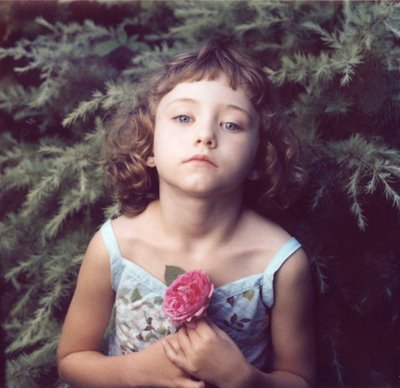
I love taking portraits and quite a long time ago I came to realize that hands could be almost as expressive as a face. But hands are difficult to photograph as they can be as big as the face. And when they are closer to the camera they can appear much bigger or when closer to a light they can overexpose. A hand in tension (or little fingers in tension) will be noticed before the face. A case in point is the little finger of Rebecca's right hand here. It detracts from what is one of my favourite pictures ever of her. It has the charm of being a Polaroid and so is one of a kind.
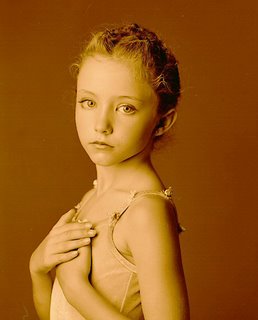
Fortunately Rebecca is taking ballet so she knows how to hold her hands with grace. With her help I have learned to take better pictures (even lawyers) as I always notice what the hands are doing.

Now that Lauren can take instructions when I photograph her I have been able to photograph her with Rebecca with some ease. I took this one last summer in the garden and Lauren is holding Rosa 'Sexy Rexy'.
In this next one Rebecca is in our back lane during a downpour. She is holding (but her hand barely shows) Rosa 'Charles de Mills'.
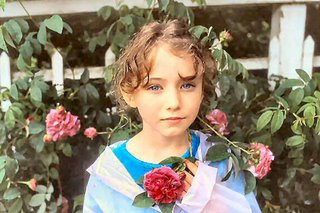
Feet can complicate things sometimes. Usually they are too far from the face to be noticed in a portrait. When Rebecca posed for me behind our gazebo with the hydrangea she asked me if she could place her leg thus. It looked very adult-like and I liked it. Rosemary didn't at first and now has begun to appreciate Rebecca's attempt at looking like an adult.

But it was only recently that I finally nailed a portrait of Rebecca and Lauren where to my mind the hands are perfect.
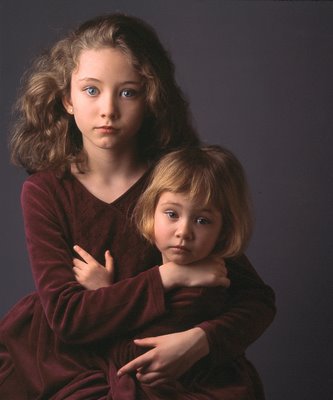
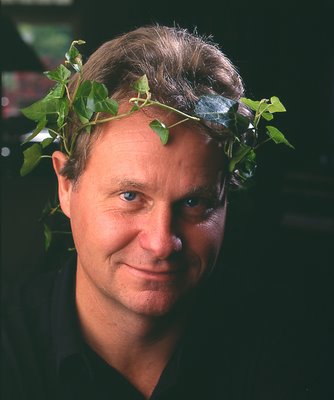
Around 2000 Time Magazine called noted oceanographer and explorer Wade Edmund Davis, Hero of the Planet. By the next year there were full page photographs of Wade Davis in the National Geographic labeling him just that. In 2001 when Davis was the Explorer-in-Residence at the National Geographic Society I was given the opportunity to take his photograph that September by the Georgia Straight > It was a thrill for me. I was going to meet this Canadian born man who had visited just about every remote spot of our planet. Surely the decision makers at the Straight were going to put him on the cover. They didn't and some unforgettable cartoon on some unforgettable editorial took Wade Davis's place.
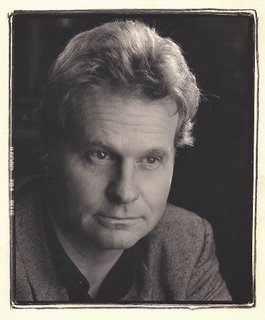
The only record of Davis's trip to Vancouver was my little picture (the b+w one) in the Straight and the Vancouver Sun made no mention of the man.
Davis had been very cooperative in posing for me and even went as far of going for my idea for the Greek hero look with ivy around his head. As a Canadian he did suggest to me that nobody was a prophet in his own country. I keep seeing his picture in the National Geographic and as he rockets into further fame I can at least enjoy here the cover that never was. Davis and I had a lot of fun doing the table top of his things on my living room floor. His luggage had been lost so all he could bring was his razor, passport, business card, Swiss Army watch and I used my Nikon F-2 which was exactly like his. I remember that the folks at the Straight had wanted me to photograph Davis as he cleared customs to show the world traveler in action. Even in 2001 it would have taken me weeks to get the necessary permission.
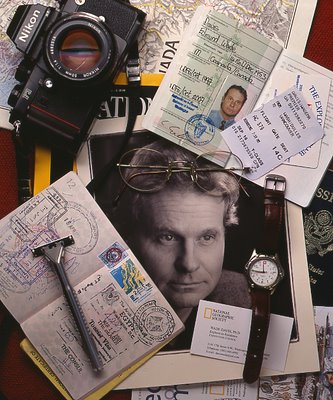
Wade Davis
Wade Davis - Explorer-in-Residence

Around 1955 my grandmother worked in the Filipino Embassy in Mexico City. When the new consul, Johnny Hormillosa arrived my grandmother took him out to see the sites of the city. In one of the restaurants they visited, she had been most embarrased when in his Filipino Spanish, Hormillosa had asked for a clean glass with water. A few weeks later Jhonny (he insisted in spelling his name that way, but then his son was called Robin after Nigaraguan poet Rubén Darío) asked my grandmother to take him to that wonderful "Egyptian restaurant" (he pronounced that Egyptzian restaowrunt). My grandmother was all confused until Jhonny described the Egyptian costumes of the waitresses. It was only then that my grandmother realized that the waitresses of the ubiquitous Sanborns restaurant/drugstores wear a uniform based on those of the Tehuanas, the Mexican Indian women of the Tehuantepec Istmus. They could be seen as Egyptian if the viewer were the Filipino consul.
Last year when I photographed Pam in Nora's living room I asked Nora to decorate it Egyptian style and to make up Pam as an Egyptian/Coptic Madonna. I couldn't explain to either Pam or Nora that Jhonny would have approved.
Sanborns Morelia
Sanborns Cancun
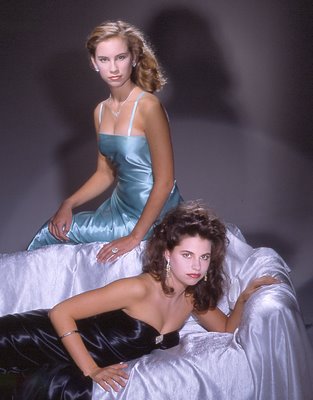
For a while in the late 80s I had a job that almost was a job. I was the Director of Photography at Vancouver Magazine. I even had a card that said that. It was my job to suggest ways of doing covers and illustrating features. I saw many illustrators and photographers during that time. I took care to not assign myself to shoot anything except when the editor, Mac Parry insisted I shoot it.
One day Mac came to me and said we needed to photograph Doc Harris ( a DJ of note then) with a woman that was beautiful and had cleavage. I immediately suggested the then very hot fashion photographer Chris Haylett to shoot it and I was in charge of finding the model. The cover had all to do with the Playhouse Wine Festival so I headed to the Vancouver Playhouse and asked to see 8x10s of their actresses and extras. I was given a pile of 100 and put them all on the floor. There were big smiles, beautiful glossy teeth and all the photos rapidly blended into one. But two photographs stood out and I picked them up and inquired as to who they were.
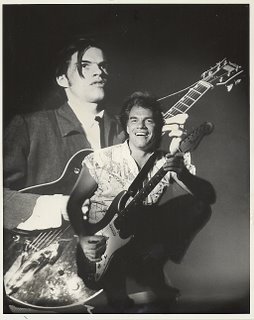
By coincidence they were sisters, Saffron and Camile Henderson, daughters of legendary BC rocker and guitarist Bill Henderson. While most of the other 8x10s had been taken by professional photographers the snaps of Saffron and Camile had been taken by their mother!
Mac and I agreed on Saffron for the cover and months later we found an excuse to run my picture of both sisters. I did these in my then huge Yaletown studio on Hamilton Street. Inga Vollmer did the makeup and (very important) made the dresses on the spot with bolts of satin I had purchased. Vollmer used safety pins and some quick sewing.
Saffron is in black and Camile in blue.

This is a not too lame excuse for avoiding my blog obligations for today. The fact is that I have to interview the dancer/choreographer Emily Molnar at 1:15 with a new voice recorder I bought yesterday. I have to be able to set the correct time on the tiny unit before I can use it. I have a few hours to figure it out. The Sony broadcast quality tape recorder cannot be fixed. It has a cracked capstan so the recorded voices speed up and slow down randomly. I first bought it in 1990 to take to Lima to interview Mario Vargas Llosa. It was there that I made the first of many mistakes that one is capable of doing with this recorder. On pause the sound level meter happily tells you of the ups and downs of your speaker and the earphones show you that the microphone is working. But at the end of one of my Vargas Llosa interviews I had nothing. My affection for the Sony has been a troubled one. I hope that the Olympus may be a little more foolproof for a man who has had problems with resistentialism a word I first read about in William Safire's column. It has all to do with objects rebelling to human masters who mistreat them thinking that since "they" are machines they have no soul and can be mistreated at will.
More on resistentialism
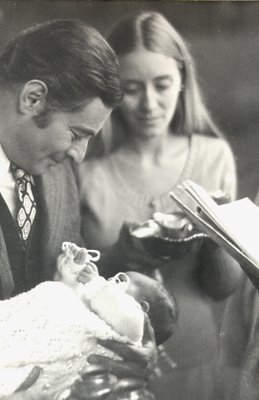
Yesterday when I picked up Rebecca to take her to her piano lesson I had new CDs (with piano music) loaded and I played a sampling. Immediately Rebecca showed interest in Satie - Piano Works - Daniel Varsano - Philippe Entremont. She wasn't too interested in Miles Davis - Kind of Blue (So What with Bill Evans on piano). She commented that André Previn and J.J. Johnson play Kurt Weill's Mack the Knife & bilbao Song and other music from The Threepenny Opera - Happy End - Mahagonny (is that a long CD/record title?), sounded oriental but she wanted more Eric Satie.
I remember exactly the year and where I first heard Eric Satie. It was in 1967 in the apartment of my friend Raúl Guerrero Montemayor. He played the definitive version at the time which was with pianist Aldo Ciccolini.
I first met Raúl at my Tia Fermina's house on Miguel Servantes Saavedra in Mexico City. Raúl spoke more than 8 languages (German with a Yiddish accent, French with a Hungarian accent and whatever variation of a language you could think of!). Although he was of Filipino heritage he was blond and blue-eyed. There were those who asserted that Raúl was the illigitimate son of the first president of the Philippines, Manuel L. Quezon. The resemblance is most striking. Raúl was also first cousin to Yvette Mimieux. Raul became my friend and began to remove some of my rough edges. He took me to see French and Italian cinema. He introduced me to the wonders of Monica Viti and Antonioni. We talked about Sartre and books. We drank coffee at a very bohemian coffee shop called La Rana Sabia (The Wise Frog). We drove to Veracruz when I was 18 and I got my first glimpse, as an adult, of the sea (in this case the Gulf of Mexico). Raúl helped me out with my courting of Rosemary and later on became godfather of Hilary (photo above left) who is Rebecca's mother.
It was Rebecca choosing to listen to Erik Satie yesterday that brought home that realization on how important Raúl has been in my life and in my life with Rosemary.
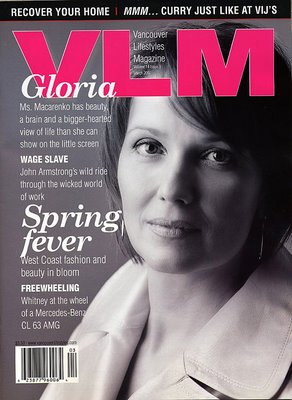
I have observed three fools in action over the years and when they finally give up there are many more of the type to occupy their place. These fools have the ambition to:
1. Publish and or edit a magazine, tabloid or newspaper.
2. Start an art gallery.
3. Open a restaurant.
It was quite a few years ago that Urban Peasant, James Barber had to withdraw from his Commercial Drive restaurant venture Arriva. He was losing his shirt. But he went on the record in a magazine article, how the experience had not turned him off. He asserted that when the opportunity rose he would start a restaurant again.
Dianne Farris once told me that she had not only mortgaged her house away to keep her gallery going but that she was also painting herself into a plumbing corner as the bathrooms did not work. But she was going to press on with her dream.
I think it is the dream that keeps these three "fools" going. You have an idea, and reality (with its instant satisfaction) can be quick in coming if you publish a weekly or a daily. I have been privy to conversations between publishers and editors where the former would swear a no inteference policy so as to keep an editorial independence. And I have seen these promises disappear as "service" peaces became the norm for keeping a magazine afloat.
As a photographer I have been promised more times than I can possibly remember, "This is a new magazine and we can only afford this much, but as soon as we become more successful we will pay you what you are really worth." I have seen young photographers, illustrators and freelance writers be given "photo" or "writing" credits instead of hard cash. I have never had the heart or the gumption to tell them that money will never come and photo credits are not proper collateral at the bank.
But would be gallery owners, restauranteurs and publisher/editors keep passing by my horizon and for the latter I am almost never able to say, "No," when asked to help out for little or no money.
Could it be that I am a dreamer, too?
The prospect of seeing a magazine with my cover photo has always been an exciting delight. My latest effort is no less a delight. It was about a month ago that experienced editor/art director Bob Mercer told me he had the project to re-brand the most horrible (my word) magazine in Vancouver.
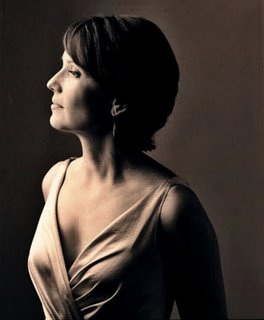
He said he wanted to turn around Vancouver Lifestyles Magazine (now called VLM)and wanted bold b+w covers. Best of all (this is how he lured me in) he wanted me to suggest who was the person I would want to photograph the most.
My answer was an easy one. I photographed the luminous Gloria Macarenko assisted by my secret weapon of so many years, stylist Maureen Willick.
When the magazine appeared last week I could not believe, that just for once, the spread looked better than I had imagined it.
I can only hope that editor/art director Bob Mercer's dream comes true.
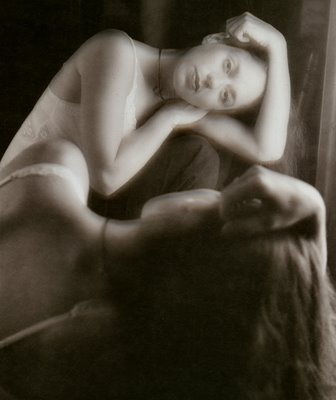
In my relationship with Rebecca and Lauren I try to look back and remember how it was with my abuelita. She was the only grandparent I ever knew. I am unsuccessfully wanting to see myself through her as I was then and I can only wonder at the parallels with my relationship with my granddaughters.
I was 8 when my grandmother took me to see all 15 episodes (244 minutes) of Spencer Gordon Bennet's Superman (with Kirk Alyn as the man of steel). I would have never known that the serials were being shown in downtown Buenos Aires as I did not read newspapers.
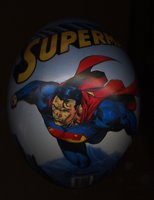
My only conclusion is that my grandmother found out about the screening independently and made the choice of volunteering to take me and sit through a 4-hour long program. All I remember is a huge stomach ache and how I cried on the train on our way back home.
Of late I have been having a bit a problem taking Rebecca to dance and concerts as not only do I have to convince her but also I must appeal and convince her mother. Just because I am older, in this day and age, does not necessarily mean that I might have a leg up on what is culturally advantageous for my Rebecca. Last night I was bitterly disappointed that Rebecca did not accompany Ale (Rebecca's aunt and my daughter) and me to watch Day Helesic's (above, left) performance as a horse (Genuine Risk) at Edam as well as seeing Rebecca's friend Anne Cooper (and Delia Brett, and Monica Strehlke) in Peter Bingham's One thing after another. Would Rebecca have been as mesmerized as Ale and I were in watching Carolyn Chan dance Jay Hirabayashi/Kokoro's Trans?
I can only wonder if my grandmother ever wanted me to see (or did she want to see? Alas! I never asked her.) a Randolph Scott Technicolor western and my mother turned her down that I had too much homework or that I was too tired.
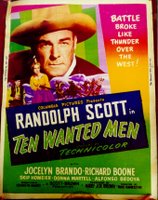
The homework is long forgotten. Would I still remember the Randolph Scott film I never saw? Would I remember my grandmother's smile as we spooned our strawbery ice cream sodas at the Roxy, around the corner from the movie houses on Lavalle?
How many times did I unknowingly disappoint her?
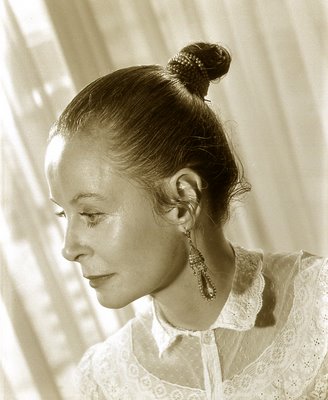
Unlikely things happen in films. Who would have ever guessed that Yuko Mishima's The Sailor Who Fell From Grace From The Sea would have been made into a movie re-set in Dover with Sarah Miles and Chris Christofferson? That was the case in 1976. I remember seeing the almost blatant nude shots of the couple in Playboy. Then I enjoyed Sarah Miles in The Big Sleep (1978) with Robert Mitchum. They had worked together to my satisfaction in Ryan's Daughter (1970).
And so I was pumped up for my photo engagement with Sarah Miles in 1987. The session almost became an anticlimax to my expectations and only now can I accept it all and even smile thinking about it.
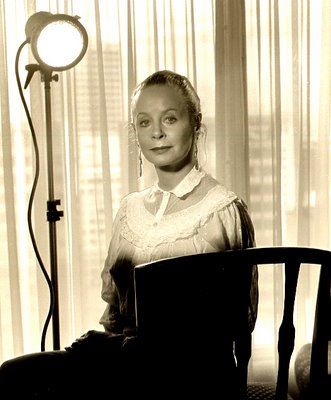
Sarah Miles faced my camera with her hair up. In a Michael Caineish accent she instructed me, "I have here a transparent blouse. Make sure my tits don't show!"

A bad cold can devastate an old guy like me. As I walked down the stairs this morning nothing was working and the knees just about buckled. It made me remember Vancouver dancer Cori Caulfield who can walk, move, dance with such ease as if she had Teflon in her joints. And so I have the opportunity to put up this photo of her which is one of my favourite pictures ever of a dancer.
Cori's back is all that one that I saw so many years ago wasn't. I was with my father and we were taking the subte back from a movie on Lavalle Street. We were on our way to Retiro station and the train to Coghlan. It was near carnival and I spotted the bare back of a woman on end of the other subway car. There was a lot of singing and chanting. It was one of those murgas or carnival street bands that sing the samba in the streets of Buenos Aires during carnival. I was repelled by the woman's muscular and ugly back. I was only 8 or 9 and I did not understand at the time that she was probably a man dressed as a woman.
In some way when I photographed Cori with her apple I exorcised that terrible image from so long ago.
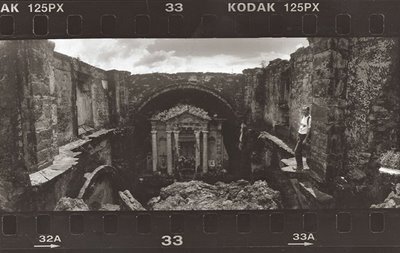
On those Friday evenings of long ago we could smell the humidity and hear the insects as our VW went down from Mexico City's 2250 meters to Xalapa's (in the state of Veracruz) near sea level. In the darkness, our VW's ancient 6 volt headlamps could not show us the spectacular gamut of greenness of the jungle vegitation that defines for me what Xalapa was and is. But we had passed through Xalapa enough times during the day to remember the green of this city of coffee and the famous Olmec heads of its anthropolgy museum. It was a green that may have eluded a young woman that I spied staring at shot glass of creme the menthe at a Jefferson Airplane concert I had attended in San Francisco in 1967. No drugs could have revealed for her the greenness that Rosemary and I could imagine, and, at the same time smell in Xalapa on our way to Veraruz and my mother. We would look forward to the unmuffled sounds of sea level and the smell of salt and the Gulf of Mexico.
If a blog has a limitation it is here where it is obvious. You cannot smell nor in its present configuration hear any sounds. Worse of all there is no room for the space of a panoramic that will show the scope of Mexico's landscapes or the wonder of its ruins. Forunately in Andrew at Paricutin (above left), Rebecca was there when I took my friend's picture last year.
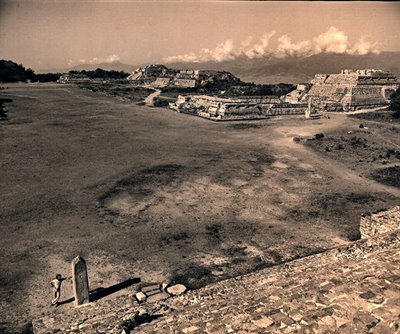
Maybe this year, if we go to Oaxaca, she will also understand the scope of the ruins of Montealbán. Jorge, Andrew's friend and mine can be seen here leaning on a stella at the bottom left.

Marc Destrubé and the Axelrod Quartet will be playing Beethoven's Op 132 (5 movements): March 15, 2007, 8:pm, Scotiabank Dance Centre, 677 Davie Street with Peter Hannan, Kenton Lowen and Pissed Of Wild (in no particular order).
“Peugeot 505s are solid cars. They are used as taxis in Buenos Aires and all over Africa.”
Marc Destrubé
I always notice people who drive Peugeots or any other French cars. They are few. Most of these drivers are stubborn individuals. One of them to me looks like Antonio Vivaldi or Nicolo Paganini. I think I make this connection because I know he is Vancouver violinist Marc Destrubé.
Goethe likened listening to a string quartet to "eavesdropping on a conversation among four intelligent people." Perhaps that's why listening to one can seem like a such an intimidating experience, unlike, say, listening to an orchestra. Vancouver musician Marc Destrubé, first violinist of the Smithsonian's Axelrod Quartet, one of the world's best, thinks the experience should be anything but intimidating. "Our repertoire is immensely warm and inviting," Destrubé says. "Yes, I'm in the middle of it. But you have the chance to listen in on a private conversation among four individuals. Whereas a concert by the Pacific Baroque Orchestra, which Destrubé founded and has directed since 1991, is like going to a pop concert, the music being thrown at you. You are not looking into someone else's activity. The activity is there to please you."
I disagree with Destrubé's pop concert comparison. His violin playing adds that extra brilliance to the PBO concerts. But he may be right when he tells me, "Baroque music is a door into the appreciation of the music that followed it." After years of being enthused with baroque music I now have a nascent interest in the music of the 19th century as represented by quartets and other small orchestras. And I may be one of many others. It is only recently that I have also been interested in what in Vancouver is called New Music and often is presented by the society of that name, The Vancouver New Music Society. Being able to listen to this new music by Marc Destrubé, who has always made music warm and inviting makes this concert a hard one to miss.
In 1998 the Smithsonian's Smithson String Quartet changed its name to its present one after it received a gift from the self-taught ichthyologist and tropical fish expert Herbert Axelrod. The gift was a quartet (two violins, one viola and cello) of exquisitely decorated Antonio Stradivari instruments. Destrubé's instrument of choice, the 1709 "Greffuhle" Stradivari, is inlaid with gryphons and spotted leopards. Those leopards and gryphons must have their influence. Of playing on the Greffuhle, Destrubé says, "It has an intimate sound but a strong personality as if it were alive and you are going to battle with it." A seemingly out-of-the- blue offer, in April 2002, to be the first violinist of the Axelrod Quartet came at the right time for Destrubé.
Until 2002, as concertmaster of the CBC Radio Orchestra, he had such a gruelling playing and teaching schedule that it became impossible to juggle his concertmaster tasks with his international commitments. Diversity is another reason for Destrubé's success. He is a soloist, a director, a concertmaster for various orchestras, a teacher, and plays baroque, 19th- and 20th-century music. He has a soft spot for Russian composer Alfred Schnittke (1934 - 1998). As a director of the PBO he has commissioned works from contemporary Canadian composers, including Thursday night's performer/composer Peter Hannan.
And somehow he finds the time to take his wife and two children on camping holidays. The Victoria-raised Destrubé has an interesting background that may explain his attraction to diversity. His father, while a French Second World War prisoner of war in a camp in Austria in 1944, became sick and was transferred to a hospital in Villach. There he met his soon-to-be wife, a young German doctor. Such were the mechanical skills of the senior Destrubé that he soon was repairing hospital equipment and taking the pre-operation x-rays. Fudging on his health status, while being careful not to cross the Nazi hospital administrators, Destrubé never returned to his camp and married the doctor at the end of the war. An uncle who had moved from London to start a general store in Northern Alberta at the turn of the 20th century had retired in Victoria. The Destrube's moved there. To this day, Marc Destrubé drives French cars because, "My father always drove one." Destrubé's achievement at 52 is extraordinary, when you consider he became a musician later in life than normal. "I wasn't a prodigy. I made the decision to be a musician when I was 17 after I had started my pre-med studies. I then just worked hard [beginning at the Victoria Conservatory of Music]." By 1987 he was the first violinist for the Purcell String Quartet and was a founding member of Tafelmusik. Destrubé explained the challenge in quartet playing. "It involves skills that have to do with one's imagination as a musician. One must not only get along but also work with three people in an intense situation. It is the ability, as a first violinist, to stand out as a greater amongst equals and to be willing to discuss musical points on an equal level."
I have watched Destrubé at PBO rehearsals and I can confirm that he has a soft-spoken authority that must serve him well in the quartet.
Adendum by Marc Destrubé
Dear friends,
I thought you might like to at least know about this most unusual concert. The Axelrod Quartet will be playing Beethoven Op. 132 (5 movements), Kenton Loewen (amazing drummer) and I will be playing Peter Hannan's new piece (5 parts), with live electronics, and Pissed Off Wild (Kenton's band - the name says it all) will play (5 songs), all this in no particular order, and we'll all do something together at the end.
Marc
Vancouver New Music
Rebecca's Hands
Sunday, March 11, 2007

I love taking portraits and quite a long time ago I came to realize that hands could be almost as expressive as a face. But hands are difficult to photograph as they can be as big as the face. And when they are closer to the camera they can appear much bigger or when closer to a light they can overexpose. A hand in tension (or little fingers in tension) will be noticed before the face. A case in point is the little finger of Rebecca's right hand here. It detracts from what is one of my favourite pictures ever of her. It has the charm of being a Polaroid and so is one of a kind.

Fortunately Rebecca is taking ballet so she knows how to hold her hands with grace. With her help I have learned to take better pictures (even lawyers) as I always notice what the hands are doing.

Now that Lauren can take instructions when I photograph her I have been able to photograph her with Rebecca with some ease. I took this one last summer in the garden and Lauren is holding Rosa 'Sexy Rexy'.
In this next one Rebecca is in our back lane during a downpour. She is holding (but her hand barely shows) Rosa 'Charles de Mills'.

Feet can complicate things sometimes. Usually they are too far from the face to be noticed in a portrait. When Rebecca posed for me behind our gazebo with the hydrangea she asked me if she could place her leg thus. It looked very adult-like and I liked it. Rosemary didn't at first and now has begun to appreciate Rebecca's attempt at looking like an adult.

But it was only recently that I finally nailed a portrait of Rebecca and Lauren where to my mind the hands are perfect.

Wade Davis - Hero Of The Planet (But Not In Vancouver)
Saturday, March 10, 2007

Around 2000 Time Magazine called noted oceanographer and explorer Wade Edmund Davis, Hero of the Planet. By the next year there were full page photographs of Wade Davis in the National Geographic labeling him just that. In 2001 when Davis was the Explorer-in-Residence at the National Geographic Society I was given the opportunity to take his photograph that September by the Georgia Straight > It was a thrill for me. I was going to meet this Canadian born man who had visited just about every remote spot of our planet. Surely the decision makers at the Straight were going to put him on the cover. They didn't and some unforgettable cartoon on some unforgettable editorial took Wade Davis's place.

The only record of Davis's trip to Vancouver was my little picture (the b+w one) in the Straight and the Vancouver Sun made no mention of the man.
Davis had been very cooperative in posing for me and even went as far of going for my idea for the Greek hero look with ivy around his head. As a Canadian he did suggest to me that nobody was a prophet in his own country. I keep seeing his picture in the National Geographic and as he rockets into further fame I can at least enjoy here the cover that never was. Davis and I had a lot of fun doing the table top of his things on my living room floor. His luggage had been lost so all he could bring was his razor, passport, business card, Swiss Army watch and I used my Nikon F-2 which was exactly like his. I remember that the folks at the Straight had wanted me to photograph Davis as he cleared customs to show the world traveler in action. Even in 2001 it would have taken me weeks to get the necessary permission.

Wade Davis
Wade Davis - Explorer-in-Residence
The Egyptian Restaurant
Friday, March 09, 2007

Around 1955 my grandmother worked in the Filipino Embassy in Mexico City. When the new consul, Johnny Hormillosa arrived my grandmother took him out to see the sites of the city. In one of the restaurants they visited, she had been most embarrased when in his Filipino Spanish, Hormillosa had asked for a clean glass with water. A few weeks later Jhonny (he insisted in spelling his name that way, but then his son was called Robin after Nigaraguan poet Rubén Darío) asked my grandmother to take him to that wonderful "Egyptian restaurant" (he pronounced that Egyptzian restaowrunt). My grandmother was all confused until Jhonny described the Egyptian costumes of the waitresses. It was only then that my grandmother realized that the waitresses of the ubiquitous Sanborns restaurant/drugstores wear a uniform based on those of the Tehuanas, the Mexican Indian women of the Tehuantepec Istmus. They could be seen as Egyptian if the viewer were the Filipino consul.
Last year when I photographed Pam in Nora's living room I asked Nora to decorate it Egyptian style and to make up Pam as an Egyptian/Coptic Madonna. I couldn't explain to either Pam or Nora that Jhonny would have approved.
Sanborns Morelia
Sanborns Cancun
Saffron, Camile and Bill Henderson
Thursday, March 08, 2007

For a while in the late 80s I had a job that almost was a job. I was the Director of Photography at Vancouver Magazine. I even had a card that said that. It was my job to suggest ways of doing covers and illustrating features. I saw many illustrators and photographers during that time. I took care to not assign myself to shoot anything except when the editor, Mac Parry insisted I shoot it.
One day Mac came to me and said we needed to photograph Doc Harris ( a DJ of note then) with a woman that was beautiful and had cleavage. I immediately suggested the then very hot fashion photographer Chris Haylett to shoot it and I was in charge of finding the model. The cover had all to do with the Playhouse Wine Festival so I headed to the Vancouver Playhouse and asked to see 8x10s of their actresses and extras. I was given a pile of 100 and put them all on the floor. There were big smiles, beautiful glossy teeth and all the photos rapidly blended into one. But two photographs stood out and I picked them up and inquired as to who they were.

By coincidence they were sisters, Saffron and Camile Henderson, daughters of legendary BC rocker and guitarist Bill Henderson. While most of the other 8x10s had been taken by professional photographers the snaps of Saffron and Camile had been taken by their mother!
Mac and I agreed on Saffron for the cover and months later we found an excuse to run my picture of both sisters. I did these in my then huge Yaletown studio on Hamilton Street. Inga Vollmer did the makeup and (very important) made the dresses on the spot with bolts of satin I had purchased. Vollmer used safety pins and some quick sewing.
Saffron is in black and Camile in blue.
The Old Sony, The New Olympus & Resistentialism
Wednesday, March 07, 2007

This is a not too lame excuse for avoiding my blog obligations for today. The fact is that I have to interview the dancer/choreographer Emily Molnar at 1:15 with a new voice recorder I bought yesterday. I have to be able to set the correct time on the tiny unit before I can use it. I have a few hours to figure it out. The Sony broadcast quality tape recorder cannot be fixed. It has a cracked capstan so the recorded voices speed up and slow down randomly. I first bought it in 1990 to take to Lima to interview Mario Vargas Llosa. It was there that I made the first of many mistakes that one is capable of doing with this recorder. On pause the sound level meter happily tells you of the ups and downs of your speaker and the earphones show you that the microphone is working. But at the end of one of my Vargas Llosa interviews I had nothing. My affection for the Sony has been a troubled one. I hope that the Olympus may be a little more foolproof for a man who has had problems with resistentialism a word I first read about in William Safire's column. It has all to do with objects rebelling to human masters who mistreat them thinking that since "they" are machines they have no soul and can be mistreated at will.
More on resistentialism
Raúl Guerrero Montemayor & Erik Satie
Tuesday, March 06, 2007

Yesterday when I picked up Rebecca to take her to her piano lesson I had new CDs (with piano music) loaded and I played a sampling. Immediately Rebecca showed interest in Satie - Piano Works - Daniel Varsano - Philippe Entremont. She wasn't too interested in Miles Davis - Kind of Blue (So What with Bill Evans on piano). She commented that André Previn and J.J. Johnson play Kurt Weill's Mack the Knife & bilbao Song and other music from The Threepenny Opera - Happy End - Mahagonny (is that a long CD/record title?), sounded oriental but she wanted more Eric Satie.
I remember exactly the year and where I first heard Eric Satie. It was in 1967 in the apartment of my friend Raúl Guerrero Montemayor. He played the definitive version at the time which was with pianist Aldo Ciccolini.
I first met Raúl at my Tia Fermina's house on Miguel Servantes Saavedra in Mexico City. Raúl spoke more than 8 languages (German with a Yiddish accent, French with a Hungarian accent and whatever variation of a language you could think of!). Although he was of Filipino heritage he was blond and blue-eyed. There were those who asserted that Raúl was the illigitimate son of the first president of the Philippines, Manuel L. Quezon. The resemblance is most striking. Raúl was also first cousin to Yvette Mimieux. Raul became my friend and began to remove some of my rough edges. He took me to see French and Italian cinema. He introduced me to the wonders of Monica Viti and Antonioni. We talked about Sartre and books. We drank coffee at a very bohemian coffee shop called La Rana Sabia (The Wise Frog). We drove to Veracruz when I was 18 and I got my first glimpse, as an adult, of the sea (in this case the Gulf of Mexico). Raúl helped me out with my courting of Rosemary and later on became godfather of Hilary (photo above left) who is Rebecca's mother.
It was Rebecca choosing to listen to Erik Satie yesterday that brought home that realization on how important Raúl has been in my life and in my life with Rosemary.
Three Fools & Gloria Macarenko
Monday, March 05, 2007

I have observed three fools in action over the years and when they finally give up there are many more of the type to occupy their place. These fools have the ambition to:
1. Publish and or edit a magazine, tabloid or newspaper.
2. Start an art gallery.
3. Open a restaurant.
It was quite a few years ago that Urban Peasant, James Barber had to withdraw from his Commercial Drive restaurant venture Arriva. He was losing his shirt. But he went on the record in a magazine article, how the experience had not turned him off. He asserted that when the opportunity rose he would start a restaurant again.
Dianne Farris once told me that she had not only mortgaged her house away to keep her gallery going but that she was also painting herself into a plumbing corner as the bathrooms did not work. But she was going to press on with her dream.
I think it is the dream that keeps these three "fools" going. You have an idea, and reality (with its instant satisfaction) can be quick in coming if you publish a weekly or a daily. I have been privy to conversations between publishers and editors where the former would swear a no inteference policy so as to keep an editorial independence. And I have seen these promises disappear as "service" peaces became the norm for keeping a magazine afloat.
As a photographer I have been promised more times than I can possibly remember, "This is a new magazine and we can only afford this much, but as soon as we become more successful we will pay you what you are really worth." I have seen young photographers, illustrators and freelance writers be given "photo" or "writing" credits instead of hard cash. I have never had the heart or the gumption to tell them that money will never come and photo credits are not proper collateral at the bank.
But would be gallery owners, restauranteurs and publisher/editors keep passing by my horizon and for the latter I am almost never able to say, "No," when asked to help out for little or no money.
Could it be that I am a dreamer, too?
The prospect of seeing a magazine with my cover photo has always been an exciting delight. My latest effort is no less a delight. It was about a month ago that experienced editor/art director Bob Mercer told me he had the project to re-brand the most horrible (my word) magazine in Vancouver.

He said he wanted to turn around Vancouver Lifestyles Magazine (now called VLM)and wanted bold b+w covers. Best of all (this is how he lured me in) he wanted me to suggest who was the person I would want to photograph the most.
My answer was an easy one. I photographed the luminous Gloria Macarenko assisted by my secret weapon of so many years, stylist Maureen Willick.
When the magazine appeared last week I could not believe, that just for once, the spread looked better than I had imagined it.
I can only hope that editor/art director Bob Mercer's dream comes true.
A Horse, Day Helesic & Randolph Scott
Sunday, March 04, 2007

In my relationship with Rebecca and Lauren I try to look back and remember how it was with my abuelita. She was the only grandparent I ever knew. I am unsuccessfully wanting to see myself through her as I was then and I can only wonder at the parallels with my relationship with my granddaughters.
I was 8 when my grandmother took me to see all 15 episodes (244 minutes) of Spencer Gordon Bennet's Superman (with Kirk Alyn as the man of steel). I would have never known that the serials were being shown in downtown Buenos Aires as I did not read newspapers.

My only conclusion is that my grandmother found out about the screening independently and made the choice of volunteering to take me and sit through a 4-hour long program. All I remember is a huge stomach ache and how I cried on the train on our way back home.
Of late I have been having a bit a problem taking Rebecca to dance and concerts as not only do I have to convince her but also I must appeal and convince her mother. Just because I am older, in this day and age, does not necessarily mean that I might have a leg up on what is culturally advantageous for my Rebecca. Last night I was bitterly disappointed that Rebecca did not accompany Ale (Rebecca's aunt and my daughter) and me to watch Day Helesic's (above, left) performance as a horse (Genuine Risk) at Edam as well as seeing Rebecca's friend Anne Cooper (and Delia Brett, and Monica Strehlke) in Peter Bingham's One thing after another. Would Rebecca have been as mesmerized as Ale and I were in watching Carolyn Chan dance Jay Hirabayashi/Kokoro's Trans?
I can only wonder if my grandmother ever wanted me to see (or did she want to see? Alas! I never asked her.) a Randolph Scott Technicolor western and my mother turned her down that I had too much homework or that I was too tired.

The homework is long forgotten. Would I still remember the Randolph Scott film I never saw? Would I remember my grandmother's smile as we spooned our strawbery ice cream sodas at the Roxy, around the corner from the movie houses on Lavalle?
How many times did I unknowingly disappoint her?
Sarah Miles Did Not Reveal Her Breasts
Saturday, March 03, 2007

Unlikely things happen in films. Who would have ever guessed that Yuko Mishima's The Sailor Who Fell From Grace From The Sea would have been made into a movie re-set in Dover with Sarah Miles and Chris Christofferson? That was the case in 1976. I remember seeing the almost blatant nude shots of the couple in Playboy. Then I enjoyed Sarah Miles in The Big Sleep (1978) with Robert Mitchum. They had worked together to my satisfaction in Ryan's Daughter (1970).
And so I was pumped up for my photo engagement with Sarah Miles in 1987. The session almost became an anticlimax to my expectations and only now can I accept it all and even smile thinking about it.

Sarah Miles faced my camera with her hair up. In a Michael Caineish accent she instructed me, "I have here a transparent blouse. Make sure my tits don't show!"
Cori Caulfield
Friday, March 02, 2007

A bad cold can devastate an old guy like me. As I walked down the stairs this morning nothing was working and the knees just about buckled. It made me remember Vancouver dancer Cori Caulfield who can walk, move, dance with such ease as if she had Teflon in her joints. And so I have the opportunity to put up this photo of her which is one of my favourite pictures ever of a dancer.
Cori's back is all that one that I saw so many years ago wasn't. I was with my father and we were taking the subte back from a movie on Lavalle Street. We were on our way to Retiro station and the train to Coghlan. It was near carnival and I spotted the bare back of a woman on end of the other subway car. There was a lot of singing and chanting. It was one of those murgas or carnival street bands that sing the samba in the streets of Buenos Aires during carnival. I was repelled by the woman's muscular and ugly back. I was only 8 or 9 and I did not understand at the time that she was probably a man dressed as a woman.
In some way when I photographed Cori with her apple I exorcised that terrible image from so long ago.
Xalapa, Paricutín, Mantealbán - Absolute Greenness
Thursday, March 01, 2007

On those Friday evenings of long ago we could smell the humidity and hear the insects as our VW went down from Mexico City's 2250 meters to Xalapa's (in the state of Veracruz) near sea level. In the darkness, our VW's ancient 6 volt headlamps could not show us the spectacular gamut of greenness of the jungle vegitation that defines for me what Xalapa was and is. But we had passed through Xalapa enough times during the day to remember the green of this city of coffee and the famous Olmec heads of its anthropolgy museum. It was a green that may have eluded a young woman that I spied staring at shot glass of creme the menthe at a Jefferson Airplane concert I had attended in San Francisco in 1967. No drugs could have revealed for her the greenness that Rosemary and I could imagine, and, at the same time smell in Xalapa on our way to Veraruz and my mother. We would look forward to the unmuffled sounds of sea level and the smell of salt and the Gulf of Mexico.
If a blog has a limitation it is here where it is obvious. You cannot smell nor in its present configuration hear any sounds. Worse of all there is no room for the space of a panoramic that will show the scope of Mexico's landscapes or the wonder of its ruins. Forunately in Andrew at Paricutin (above left), Rebecca was there when I took my friend's picture last year.

Maybe this year, if we go to Oaxaca, she will also understand the scope of the ruins of Montealbán. Jorge, Andrew's friend and mine can be seen here leaning on a stella at the bottom left.






